So you finally made the decision to turn that brilliant idea into a legitimate business—congratulations! You’ve probably got a whole to-do list in your mind right now, including how to market your product or service, how to determine who your target market is, and how much capital you need to actually get things going.
Of course, all of these are important parts of your business plan, but have you already settled the most basic element of your brand identity, such as choosing a brand name?
Yes, we’re talking about your brand name—It’s tough to come up with a brand name, and if you’re having difficulty brainstorming or coming up with one, that’s perfectly normal. The naming process can be tricky, but a great brand name is crucial for making a positive first impression on potential customers and standing out in your industry.
Creating the Perfect Brand Name
Coming up with the right name for your brand isn’t about fitting a certain ‘standard’ but rather about establishing a strong brand identity. Every brand is unique – don’t pigeon-hole your brand name because you think it has to fit an arbitrary standard of what other businesses are doing.
Consider your brand’s position, mission, and story as stepping stones that can lead you to a natural brand name fit. Going back to these basics is a great way to get the creative juices flowing and might help you land on a few potential name candidates for a strong brand name.
And if you need extra help coming up with name ideas, these 5 tips will help you pick out a memorable and effective brand name that your audience will remember.
Gather Ideas and Brainstorm
Before anything else, we recommend starting a thorough brainstorming session. Gather your business partners (or friends and family if you’re a solopreneur) and just start throwing potential names on the page. Add in any words, phrases, or feelings that sound right – don’t worry about perfection at this stage of creating a brand.
The trick is to come up with as many brand name ideas as possible, list them all down, and slowly tick away the bad ones until you are left with the best candidates that meet your criteria. Aim for at least 20-30 potential names to choose from.
Use Clear, Descriptive, Easy-to-Remember Words
In our experience, the best brand names aren’t the super odd or out there ones, but the ones that are easy to remember (and spell when you’re looking them up online).
Try using words that can be easily connected back to your product, service, or business, the mission your company stands for, and what potential customers can expect from your brand. Stay away from made-up words or obscure names that customers won’t be able to immediately grasp or connect with your offering.
Make Sure It’s Unique
The last thing you want to deal with is a lawsuit or brand confusion, so before setting your heart on a brand name, thoroughly research and make 100% sure another brand isn’t already using it – especially in your same industry and location. Search business registries, Google, and social media to confirm no other brands are actively operating under that name.
If you get an exact name match, there might still be some wiggle room in the process to pick a name that works for your brand. For example, is the existing business operating in a completely unrelated industry or location from your potential customers? Even if there’s no risk of market confusion, we still recommend tweaking your brand name slightly (adding descriptive initials, locality, or product type) to ensure complete uniqueness.
Another important note here: As you’re considering final brand names, check domain name availability. If your team has their heart set on a certain name, you may be able to purchase the domain rights from the current owner, but you’ll definitely want to negotiate that before finalizing your brand name decision.
Skip the Buzz Words
Using trendy buzzwords in your brand name is one way to try and make it memorable or modern. It can even help you temporarily appeal to a younger target market. But at the end of the day, lingo trends come and go.
If you want your brand to stand the test of time, it needs a name that won’t lose relevance or become cringy in a few months or years. Save the trendy lingo for timely marketing campaigns and taglines instead!
Make Sure the Name Aligns With Your Brand Identity
Whatever brand name you land on should complement the rest of your branding like logos, taglines, and slogans. Brand consistency across touchpoints is critical for recognition and growth, and it all starts with an aligned brand name.
For example, if your brand name is clever or humorous, you’ll want subsequent branding elements to match – not clash with – that more relaxed, fun tone and style.
Now that you’ve got a great brand name, it’s time to start putting it out there and actively promoting your unique brand identity. Learn how to build a complete brand marketing strategy from the ground up here.
More Tips for Coming Up With the Right Brand Name
The brand naming process takes time. While coming up with dozens of name ideas is a good starting point, narrowing down your options to find the perfect name can be tricky.
Beyond the criteria already discussed, here are some additional considerations as you evaluate potential names for a powerful brand name:
Get Input From Others
It’s hard to be objective when you’ve been staring at a list of potential names for weeks. Consider showing your top 5-10 contenders to others to get unbiased input. Create polls on social media or run focus groups of people who match your target audience to help pick a name that resonates.
Listen for which option people best understand and can recall later. If multiple finalists get confused reactions, it’s back to the drawing board.
Say Names Out Loud
A name can look great on paper but be surprisingly hard to pronounce naturally in conversation. Before officially deciding, say your finalist names out loud, include them in sample ad copy, etc. If words are often mispronounced or awkwardly voiced, that’s a red flag.
Watch for Unintended Meanings
Words that seem perfectly innocent in your native language may have alternate connotations or translations elsewhere. Do some international due diligence by translating shortlisted names into major global languages. Eliminate ones with unfortunate secondary meanings.
Check URL Availability
Your brand name will become your website URL, social handles, email addresses and more. Beyond checking if a .com domain is available, also run shortlisted names through platforms like Twitter, LinkedIn and Gmail.
If the versions with your name are taken, that can limit marketing. Try adding a location or descriptor word to open up more available URL options.
Imagine Referral Scenarios
Envision how customers might refer others to your yet-to-launch company. Come up with realistic word of mouth scenarios. If the names are overly complex to accurately repeat from memory or lead to confusion, it may be challenging to gain traction.
Research Legal Considerations
Beyond trademark conflicts, ensure your name choices meet legal naming requirements for your entity type and jurisdiction. Especially for heavily regulated industries like healthcare or finance, confirm names pass necessary compliance rules first.
By going through this expanded checklist before finalizing your ultimate new brand name, you give it the greatest chance at resonating in the market and communicating what you stand for.
Examples of Effective Brand Names
Here are some real-world examples of brand names that made their business name into a powerful brand. While there are many examples and types of brand names, these companies have managed to pick a brand name that’s easy to spell, builds brand recognition, and is easy to remember.
Slack – Simple and Descriptive
Slack’s name works on multiple levels. As a messaging app designed to enable seamless workplace communication, “slack” describes both the experience it enables users to have, as well as neatly fitting the positioning as an antidote to “work chaos”. The one-syllable word is supremely easy to say and remember.
Without knowing anything about Slack’s product, you can infer it likely involves casual, back-and-forth messaging functionality simply by hearing its name. The name choice has supported strong viral growth through word of mouth, since “Slack” is effortless to accurately explain to others.
Roomba – Hints at Functionality
Roomba’s name uses a blend of made-up words and real terms to paint a descriptive picture for customers. The “room” portion gives a literal connection to the vacuum’s purpose, cleaning room-by-room. But “boomba” adds a playful element that hints at how the device maneuvers around with a mix of randomness and logic.
This blend gives customers enough context to grasp what Roombas do, while still coming across as fun and approachable. The quirky name fuels buyer curiosity while answering basic questions about Roomba’s cleaning functionality right upfront through the name itself.
Mailchimp – Friendly and Clever
One standout aspect of Mailchimp’s brand name is how the company has fully embraced the “chimp” portion through its iconic branded mascot, Freddie. This consistent tie-back gives the somewhat odd name choice an approachable, friendly face.
But on a deeper level, the name fuses together “email” and “chimp” to connect directly to Mailchimp’s initial product offering of email marketing services, enhanced through a friendly primate mascot. The name takes a basic software function and adds unique personality. And customers can immediately grasp the link back to email tools by hearing the “mail” prefix.
The alliteration makes “Mailchimp” satisfyingly fun to say aloud, with customers often referring to the company verbally in conversation about marketing solutions. In a relatively boring software space, the energized name delivers vitality.
Shutterfly – Hints at Ease and Speed
As an early dot-com era startup in online photos, Shutterfly’s name aims to fuse photography with mobility and simplicity. The “shutter” portion ties directly back to capturing photos, while “fly” gives movement and freedom. There’s also a subtle connection to memories flying by.
The smooth combination into a single word paints an effective descriptive picture for customers of what the company enables. And that clarity and resonance has allowed Shutterfly to expand over the years into adjacent categories like cards, photo books and coordinated gifting options while retaining strong consistency with its original core name and brand story.
Choose a Brand Name That Brings Your Story to Life
Finding a brand name aligning perfectly with your business goals, values, and offerings takes effort. But the investment is well worth it in the long run. An authentic, perfect brand name makes connecting with your audience intuitive and helps propel growth.
Once you’ve checked all the boxes and made your final selection, it’s time to start spreading the word. Bring your new name to life across marketing materials, signage, digital properties and anywhere customers interact with your company (shameless plug here – the Marq platform is great for this). Consistent and targeted usage of a perfectly crafted name can elevate a business from unknown startup to household brand over time.
When in doubt, don’t be afraid to enlist some external support through resources like online brand name generators, naming agencies, or brand identity consultants to help guide you to make the right choice. But make sure to still weigh all names against your core brand values, mission and identity.
The most important thing is that your brand name feels like an authentic representation of who you are and what you offer as an organization. The rest will naturally follow with a consistent, strategic brand marketing approach.
Summoning creative inspiration can be a little like eating peanut butter on saltines while you’ve got cottonmouth. In other words: It can be difficult.
If we’re being completely honest, it’s safe to say that some days are just harder than others. And on those days, it’s easy to feel lonely in your pursuit of content marketing. But here’s the thing — you’re not. You don’t have to fly solo or reinvent the wheel. There’s a whole big world of marketing experts out there, replete with wonderful knowledge, sage advice and whatever else you can dream up.
So whether you’re crafting up a blog post like yours truly here, designing a bland (but “make it inspired!”) marketing brochure or wrangling some content for social media, you can look to our listicle of marketing quotes to get you jump-started — or to share with others!
Famous marketing quotes
“People don’t buy what you do, they buy why you do it.”
Simon Sinek
“Instead of interrupting, work on attracting.”
Dharmesh Shah
“I’ve learned that people will forget what you said, people will forget what you did, but people will never forget how you made them feel.”
Maya Angelou
“Good marketers see consumers as complete human beings with all the dimensions real people have.”
Jonah Sachs
“Our job is to connect to people, to interact with them in a way that leaves them better than we found them, more able to get where they’d like to go.”
Seth Godin
“Marketing is really just about sharing your passion.”
Michael Hyatt
Branding marketing quotes
“It’s quite fun to do the impossible.”
Walt Disney
“Behind every piece of bad content is an executive who asked for it.”
Michael Brenner
“A brand is no longer what we tell the consumer it is — it is what consumers tell each other it is.”
Scott Cook
“Making promises and keeping them is a great way to build a brand.”
Seth Godin
“Your brand is a story unfolding across all customer touchpoints.”
Jonah Sachs
“Do one thing every day that scares you.”
Eleanor Roosevelt
Social media marketing quotes
“Content is fire, social media is gasoline.”
Jay Baer
“Social media is about sociology and psychology more than technology”
Brian Solis
“Build it, and they will come” only works in the movies. Social Media is a “build it, nurture it, engage them and they may come and stay.”
Seth Godin
“Social media is about the people. Not about your business. Provide for the people and the people will provide for you.”
Matt Goulart
“Social media requires that business leaders start thinking like small-town shop owners. This means taking the long view and avoiding short-term benchmarks to gauge progress. It means allowing the personality, heart, and soul of the people who run all levels of the business to show.”
Gary Vaynerchuk
Content marketing quotes
“You can’t sell anything if you can’t tell anything.”
Beth Comstock
“Content builds relationships. Relationships are built on trust. Trust drives revenue.”
Andrew Davis
“Not viewing your email marketing as content is a mistake.”
Chris Baggott
“Whether B2B or B2C, I believe passionately that good marketing essentials are the same. We all are emotional beings looking for relevance, context and connection.”
Beth Comstock
“What separates good content from great content is a willingness to take risks and push the envelope.”
Brian Halligan
“Quality content means content that is packed with clear utility and is brimming with inspiration, and it has relentless empathy for the audience.”
Ann Handley
Storytelling marketing quotes
“Marketing is no longer about the stuff that you make, but about the stories you tell.”
Seth Godin
“Good content isn’t about good storytelling. It’s about telling a true story well.”
Ann Handley
“I’ve learned that people will forget what you said, people will forget what you did, but people will never forget how you made them feel.”
Maya Angelou
“If your stories are all about your products and services, that’s not storytelling. It’s a brochure. Give yourself permission to make the story bigger.”
Jay Baer
“The most powerful person in the world is the storyteller. The storyteller sets the vision, values, and agenda of an entire generation that is to come.”
Steve Jobs
At the end of the day
“Inspiration doesn’t respond to meeting requests. You can’t schedule greatness.”
Jay Baer
Your brand needs to go the distance. A memorable brand shows up for their customers. But, cultivating that type of experience is a whole other story. Because regardless of your role in marketing or what type of marketing content you’re creating, knowing and understanding the effectiveness of your content is the key to being “that brand” for “that customer — learn more about what constitutes effective content and how to begin nurturing it for your brand.
Storytelling has the incredible ability to connect people on a deep, emotional level. It brings us together as we feel empathy for one another, laugh together and relate to someone else. Figures and stats aren’t emotionally charged and interesting. People want to hear stories that are relatable and trigger feelings within them. And, in the world of marketing, brand storytelling can have a massive impact on your company and the following you receive.
Related: How Airbnb & Apple use storytelling marketing to build their brands
With so many competing brands out there, it’s essential that you set yourself apart from the crowd, make yourself known and tell your brand story. A brand with a compelling story can connect with people in a way that draws them to you and gives you their loyalty. So many companies fail to see the importance in relating to their customer base this way. But, it’s not that difficult to build strong emotional connections with your customers with a captivating history of your reason for being.
How to write a brand story
1. Why do you exist?
There’s always a reason why you’ve made the decision to start your business. It could be something as simple as providing a high-quality product, because you had been disappointed by what was already available—or perhaps it’s something with a deeper, more introspective meaning. Regardless of the reason for your existence, you’ve got to tell your story.
2. Explain your history
Although it may not seem so interesting to you, your customers want to hear the history of how you went from the idea of your company to what exists today. A hard-fought underdog story can be incredibly relatable to many people who have gone through hardships or struggle, and it can be inspirational for someone currently in the same position.
If there isn’t much behind your history, a fun and fantastical story always makes for a memorable experience. As long as you aren’t misleading your customers into thinking you are something that you’re not, a fictional story is a great way to add some interest to your history.
When you’re building a brand story, you’ll also develop your own tone of voice and other assets. Make sure to keep those all in one place so they’re easy for anyone to find. Create a brand style guide using this handy template from Lucidpress.
3. Who are the characters involved?
Every story needs to have some characters in it. Your brand story will have at least a few characters: those individuals who were involved in some way or another with the conception and development of the brand. Any number of people can be a character in the story of your brand, including:
- Company founders
- Customers
- Neighbors
- Co-workers
- Chance encounters
When you’re looking to dig deep into the core of your brand story, first identify who was at the heart of the creation of the brand. And, as the brand evolves and continues to grow, more characters may be added into the story as they emerge. Keep your story and characters updated as needed.
4. State your mission
Your mission statement is essentially your basic reason for being. It outlines several things for your customers to learn about your brand:
- Why you’re in business
- What need you’re fulfilling
- The problem you’re solving
In outlining your mission statement, you’ve got to remember to stay true to yourself. After all, you and your company must live and breathe this mission statement in order to stay true to the brand and protect your brand’s reputation. If your mission statement includes environmentally friendly practices, but you drive a gas-guzzler or are found to be improperly disposing of your waste, you will significantly tarnish your brand and mission statement. But, when you live your mission statement, you show yourself and your brand to be more authentic and trustworthy.
5. What are your failures?
There are few stories of success that are without their fair share of obstacles, downturns and downright fails, so don’t be afraid to share that part of your story with your customers. After all, conflict is what makes any story interesting.
Some of the most successful people you’ve heard of have been through their fair share of failures:
- J.K. Rowling felt like the biggest failure she knew after a failed marriage, job loss and being on the verge of homelessness.
- Bill Gates dropped out of Harvard and a business he co-owned went under.
- Steven Spielberg was turned down by the University of California, not once, not twice, but three times.
Oftentimes, we feel the urge to skip over these failures and just leave a gap in our stories. But, it’s generally within those gaps that the most change and development takes places. Don’t sugarcoat the tough times, but instead be honest with your customers. You’ll be shocked at how well honesty about failure and struggle is accepted and appreciated.
Brand story example
At Lucidpress, our mission is to help every person, business or brand present themselves, so they are understood. We developed our brand story as follows:
Setting
In two decades, the digital landscape has transformed the way brands present themselves — and the world now expects great design.
Conflict
However, design isn’t a universal skill. Combine that with nearly everyone in an organization creating content and you get bad design and inconsistent branded content.
Due to this, many companies turn to strict brand controls, creating large content request backlogs for central creative teams, or else employees are allowed to create content in the wild with little direction.
Resolution
We created a brand templating platform to offer a better way. Through Lucidpress, companies scale content creation while protecting their brand.
When brands stay consistent through brand templating they last longer, grow faster, and drive more revenue.
Creating a brand story using these steps can help solidify that emotional connection with your customers, to build a bond that is hard to break. Don’t overlook the importance of writing your brand story and building that relationship.
Want to know more about how to build your brand? Download our free ebook on how to build a brand in 2020.
Telling the right story for your brand can connect you with customers and help your brand grow. But good storytelling, like any other skill, is something you have to work at. So, we asked around and got storytelling podcast recommendations from fellow marketers who love a good yarn. Here are the top 12 picks, including a few of our own favorites.
1. Building a StoryBrand

Building a StoryBrand is lauded for its entertaining episodes and inspiring insights. Donald Miller brings in big names like Matthew McConaughey and Seth Godin to talk about storytelling and crafting clear messages that will speak to your customers.
This podcast came highly recommended by Trevor Rappleye, the CEO of CorporateFilming, who said Building a StoryBrand will help you simplify your message and drive sales.
Listen to Building a StoryBrand
2. All Selling Aside
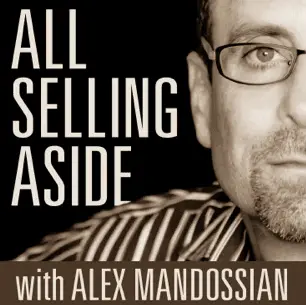
This podcast is for those who find themselves in the unfortunate position of having to sell when they actually hate selling. Host Alex Mandossian will walk you through different strategies to use the power of storytelling to achieve your sales goals.
Carol Tompkins, Business Development Consultant for AccountsPortal, recommends All Selling Aside because “it focuses on teaching consultants like myself, as well as other professionals, how to ethically influence others both personally and professionally, rather than just focusing on selling all the time.”
3. Be The Drop

Be The Drop is all about the intersection of business and good communication, and it’s sure to lift your mood. The show hosts diverse guests each week to hear how they inspire and motivate the people around them. This recommendation also came from Carol, who said that Be The Drop can ultimately help you manage your business more effectively by improving your communication skills.
4. Business of Story

Business of Story is another great bet for brand storytelling highlights. There are nearly 300 episodes, and the show even won a “Best Small Business Podcast” award in 2017. It comes recommended by John Peterson, editor at Safe Drive Gear. He told us Park Howell’s show features “brilliant business owners and entrepreneurs, handpicked influencers, startup founders, and more. The topics are always inspiring, and it leads you to astounding discoveries.”
5. Under the Influence

This popular CBC Radio program was recommended to us by Kevin Carney of Organic Growth. He says, “It’s my absolute favorite podcast about marketing and advertising, as it talks about strategy, not day-to-day tactics.” This pod isn’t specifically about storytelling, but it offers a behind-the-scenes look at the ad industry that’s sure to leave you with some interesting anecdotes.
6. The Employer Branding Podcast
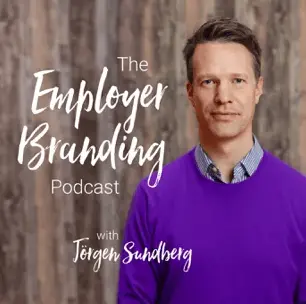
The Employer Branding Podcast offers an international take on branding in business. This recommendation came to us courtesy of Dwight Zahringer, President of Pure Cabo. He says, “Weekly episodes are 20 minutes long and super digestible, covering tons ofbranding topics with a human focus. Plus, they interview some pretty cream-of-the-crop guests from Fortune 500 companies like SalesForce to L’Oreal to Deloitte. So you’re really hearing the best insights.”
Listen to the Employer Branding Podcast
7. How Brands Are Built

This podcast offers a view of the nitty-gritty, everyday details of branding. Also recommended by Dwight, he told us, “How Brands Are Built is fantastic for understanding how to share and build momentum around your origin story. Rob Meyerson interviews an eclectic group of folks for his episodes, from marketing analysts to logo designers. You really get a 360-degree view of what’s involved in a persuasive original story, plus how to share it for max impact.”
Listen to How Brands Are Built
8. Business Storytelling Podcast
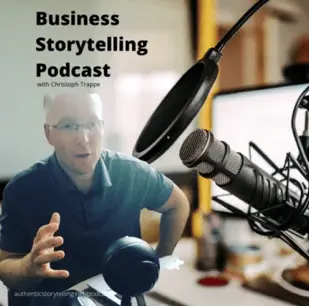
The aptly named Business Storytelling Podcast hosted by content marketer Christoph Trappe will show you how to harness the power of stories to get results. Emma Bourke, CMO at Zodiac Guides, told us this podcast “provides invaluable tips … with content that’s relevant, engaging and educational.”
Listen to Business Storytelling Podcast
Editors’ Picks
We also wanted to throw in our own top picks to get your storytelling juices flowing. Without further ado, here are some of our faves, including some outside-the-box recs and Lucidpress’s very own podcast.
9. The Visual Storytelling Podcast

The Visual Storytelling Podcast can help you round out your storytelling skills with a fresh point of view. This podcast from Disney Artist Chris Oatley will walk you through how visual artists tell stories. Touching on subjects like children’s stories and character development may have surprising impacts on your own storytelling endeavors. If anything, it’s a nice break from the world of business podcasts.
Listen to The Visual Storytelling Podcast
10. On Writing

On Writing will give you a different perspective on storytelling and can help you refine your techniques. Host Joshua Pomare talks to writers of all stripes to dig into the writing and publishing process. If you want tips from the true pros of storytelling, this is the podcast to listen to.
11. Nonprofit Storytelling Living Room
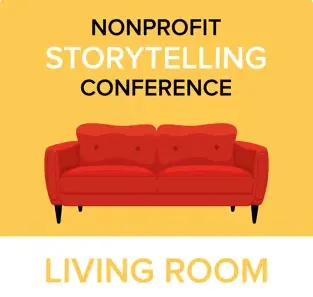
This limited series features speakers from the Nonprofit Storytelling Conference with eight different episodes doing a deep dive on how to use storytelling to accomplish your nonprofit’s goals. It’s one of the best industry-specific shows we’ve come across and can help you craft engaging stories for your audience.
Listen to Nonprofit Storytelling Living Room
12. Brand Land

Well, well, well, what have we here? Yes, it’s our very own podcast, Brand Land. Our Director of Marketing, Garrett Jestice, talks to a new guest every week from diverse fields. The show is all about how to build a trusted brand, and each guest brings their own unique insight to give you tips on brand strategy, content creation, customer experience, storytelling and more.
Data-driven decision making has gained increasing importance in marketing over the past few years due to the high availability of tools and sophisticated Martech stacks. The results? A level playing field that allows even small businesses to measure and act on customer data. It seems that nearly all companies are doing all they can to gather more market research and sales data — and what they can do to understand data implications better and apply it more effectively.
According to the joint survey published by the DMA and Winterberry Group, 40% of marketers said their companies intended to increase budgets for data-driven marketing somewhat and/or significantly. The most common marketing applications for data-driven decision making include customer journey analysis, A/B testing and personalization. While all of these are influenced by content, 44% of the respondents specifically chose copy optimization.
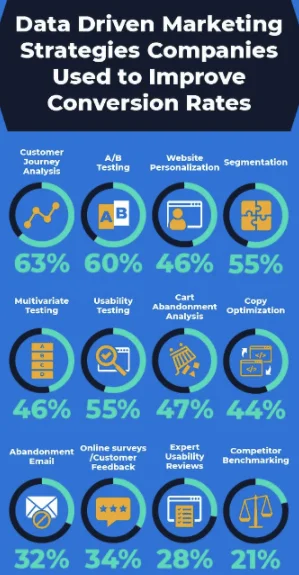
Source: https://www.invespcro.com/blog/data-driven-marketing/
There are undoubtedly countless benefits to relying on data to guide all types of strategies — but when it comes to content marketing, applying data insights can feel somewhat complicated. From what we’ve seen, marketers consistently struggle with proving ROI for content, and it seems that applying data insights can cause additional issues.
Before Covid-19 made a mockery of all surveys, opinions and empirical findings, the WARC reported in 2019 that big data management and digital transformation were among the top three challenges marketers faced across the board.
This finding leads many marketers to wonder — do all content marketing decisions need to be driven by data? What is the data’s place in developing and executing a successful content marketing strategy?
To that end, we’ve compiled a list of need-to-knows that all marketers must consider when applying data to the content creation process.
Content marketing doesn’t always deliver measurable results
One thing that sets content marketing apart from other strategies is its intention. More often than not, content creation aims to cultivate brand awareness and help customers along their journey rather than directly influencing sales.
Marketers use digital formats like blog posts, podcasts or content hubs to support the site’s overall searchability and drive in organic traffic. The most common use cases for these platforms is to highlight best practices, demonstrate product capabilities or engage existing customers. But the content isn’t necessarily intended to explicitly sell products or services — it’s more so designed to educate and inform. Many additional elements in the marketing mix lead to desired outcomes, like a conversion or however your org establishes an MQL.
Keep in mind; the modern customer journey isn’t as linear as it once was — it may take your customer up to seven separate interactions with marketing content before they even remember the brand, let alone convert.
Additionally, results aren’t always concrete. Despite the great availability of precise data from lead gen and sales-specific digital marketing channels, attribution modeling for conversions and pinpointing the exact touchpoint where a customer makes a purchase decision can be trying due to inconsistencies between the channels’ engagement data.
Content marketing is simply a building block along the customer journey — and it’s not always possible to zero in on where it fits best along the way.
What kind of (and how much) data do you have?
“Let data dictate the content you create,” is a frequent and over-used piece of advice dished out by marketing experts and keynote speakers in the industry.
The reality of data collection and application, as we all know, is different.
Now, this isn’t to say that it’s entirely impossible to utilize data when making decisions relative to content marketing. But all data is not equal — some are more relevant (and accurate) than others. Therefore, marketers must understand the difference between qualitative and quantitative data and how to use them effectively.
Quantitative data is the “hard” data points that are easily measured and organized. This includes statistics like costs, traffic numbers or sales revenue. Quantitative data is often the one that executives are most concerned with. However, quantitative data is merely just a small part of the puzzle.
Qualitative data is harder to organize, but it is equally (if not more important) than quantitative. For marketers, qualitative data points include influencer opinions, prospect intent and audience information from social media and review platforms.
Proving a direct correlation between qualitative content marketing and sales can be challenging. But other metrics like online traffic, brand recognition and customer sentiment can be cohesively and easily tied to content campaigns. Therefore, it is solidifying the importance of measuring and conveying this type of “soft” data and hard numbers when it comes to strategic planning.
One way to correlate soft data is by analyzing information like reviews or market research to measure overall sentiment before and after a campaign is completed. Using a structured process for sentiment analysis and noting any positive or negative shifts in overall remarks or ratings can be one way to prove the influence of content.
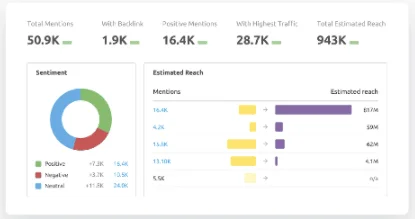
Source: https://www.semrush.com/features/brand-monitoring/
Take full advantage of technology
Thankfully, it’s become easier for content marketers to utilize available technology — like AI and machine learning — to make more data-driven content strategies.
Plus, good business leaders see the true value of investing in martech. An Adobe study on digital trends noted that top-performing businesses were twice as likely to use AI in their marketing strategies than their competitors. Even in hardcore sales (which is generally considered the antithesis to content marketing), the adoption of AI and automation technologies is predicted to increase by more than 100% as per Salesforce’s State of Sales report.
This is great news for content marketers who have long struggled to understand the data’s place in their work. New tech platforms and measuring systems make it easy to gather, organize and track metrics more accurately. What’s more — AI-enabled predictive algorithmic forecasting lets marketers precisely chart out trends and their impacts across industries in business, government and non-profit.
Correctly utilizing predictive analytics makes a content marketer’s job easier. A simple example is how marketers use Google Trends today to spot upcoming keyword trends and decide topics and themes on which to create content. Another content planning martech tool is MarketMuse, which uses AI to determine the topics that might work best for your site as well as the keywords that can generate the most traffic.

Source: https://www.marketmuse.com/
Finding balance
Although technology is becoming more common and prevalent in the content creation process, marketers need to understand its place in the overall scheme of things. Ultimately, content marketing relies on creativity and empathy, which algorithms and AI struggle to provide.
Data certainly has its place, and it can be used to support content marketing, but it must not be the end-all, be-all. As data tools become more popular to use throughout business strategies, marketers must learn how to balance their so-called human skills with technology to improve the content’s quality and results.
Customers want personalized and humanized content. So when content’s only purpose is to sell, it will likely be unsuccessful, so companies who continually dig for ROI from content marketing in terms of dollar value may be disappointed.
After all, Gary Vaynerchuck once famously asked, “What is the ROI of your mother?”
Like a relationship, content marketing is a series of conversations, and you can never assign a dollar value to each person-to-person conversation, be it parent-child or brand-customer. Consumers can sense when a piece is merely promotional and are often turned off by it. So, although an AI tool can gather hard data to “learn” about consumer segments, a content marketer is the one who actually “understands” their audience. Ultimately, it is up to content marketers to convey the value they offer without tying it directly to monetary gain.
We tell stories every day. Whether it’s a quick ditty to a friend or a long anecdote to your grandchildren, storytelling is ingrained in us. In our professional lives, we also tell stories. We tell stories to persuade someone to support a project, inspire a team, or explain a complex problem.
Storytelling is an essential skill in the professional world, but you may not be using it to its full advantage. Successful business storytelling can set you apart from your competitors and bring in loyal customers, which is why it’s essential to know how to craft a great story. We’ve created this quick guide to break down the business story writing process so you can fine-tune your storytelling skills and reap the benefits.
What is storytelling in business?
Business storytelling takes abstract concepts and complex messages and solidifies them into simple and attainable terms. It can help your customers take a non-tangible concept and relate it to concrete ideas and emotions. Storytelling in business is also the heart of inbound marketing. It’s not facts and figures that stick in our minds — it’s the stories and emotions they invoke that leave us wanting more (or have us running out to buy the new iPhone).
How many Super Bowl commercials can you remember that left you in tears? Or, ask someone and chances are they can tell you the reason why they donated to a cause or bought something. It may surprise you how often those reasons link back to a story the company told. So without further ado, let’s break down business storytelling so you can get writing.
Steps to creating a story
1. Know your audience
We’ll stress this until we’re blue in the face: Know your audience. This important piece of work will determine your message, your medium, your distribution … it may already determine your product or service. The extra time you take to dive into your audience’s demographics will pay off greatly in the long run. Without specific information on their wants and needs, you could end up with a real disaster. For example, if you are set on sending out flyers or a brochure when your audience is largely a Gen-Z crowd, you’re going to fail. Younger audiences expect that useful information is most likely going to come in digital form.
As you start research on your target market, it can help to define your buyer personas. A buyer persona can also help provide direction for the first few steps as you build out the foundation of your story. Make sure to move past age, gender and other obvious sections of their demographics. Find out what their triggers and stressors are. Even better, find out what pushed them into the content-consumption phase of their customer experience.
2. Determine your message
This, of course, is coming as number two because it doesn’t matter how long or short or where you are publishing it — your story needs to have a core message. It will be the foundation of your story moving forward. Eke out whether your story is to raise funds, advocate for an issue, explain a service or something else.
To help determine the point of your story, try summarizing your story in one simple sentence. Or give it the old elevator pitch (30 seconds or less!). If you’re unable to, you don’t have a core message, so go back to the drawing board.
3. Include a story arc with conflict and resolution
The best storytellers know that all good stories have an arc that involves a wonderful conflict apex with a tapering resolution. The conflict will be the lesson of how your character overcame a challenge. Your conflict is what will connect you to your audience through relatable experiences. Without that conflict, your story is going to be a bit boring or fall flat with your audience.
And don’t forget that every good story has a closing. Use your resolution to wrap up the story, provide context around the conflict and leave your audience with a call to action.
4. Select your medium and layout
Stories come in all shapes and forms. Some are watched, some are listened to, and others are read. There are several different ways you can distribute your story: in a video, in copy on your website, through in-person or virtual presentations, via social media, etc.
Picking the right medium for your story will probably depend on your resources and budget. Just remember that no matter which medium you choose, you want to make your message relatable to your audience.
5. Produce it
Once you’ve chosen your medium, it’s time to produce your story. The production phase will probably include a larger team than you imagine. You’ll want writers to help with a script and other creatives to aid in backdrops for a visual story or layouts for a written story. Involve your social media team to make sure what you produce will translate well on social platforms.
6. Distribute it
You’ll almost always want to share your story on social media and via email. If you’ve chosen a written story, don’t forget to publish it beyond your blog; get it guest-posted or shared on other publications. Digital stories are great on your own social media platforms, but also be sure to include them on Vimeo and YouTube. The more places you share your story, the more engagement you’ll get.
Do’s and don’ts of business storytelling
- Make the customer the hero of the story.The focus of your story should be on your audience or customer. Hone in on events you’ve witnessed or lessons you’ve learned, but try to keep yourself out of it. Your story shouldn’t be about how great you are; it will alienate your audience and could pull them away from you.
- Keep it simple: stick to one storyline and one message.Don’t let unnecessary details detract from your message. Some of the most memorable stories are straightforward and rely on the “less is more” principle. Certain details are important to include, such as emotions, the expression on a face, etc. These kinds of details help immerse your audience without distracting from your core message.
- Include a call to action.Don’t forget to include your call to action! Outline specifically what you want your audience to do after reading/watching/listening. It can be as simple as a colorful share button at the bottom of a screen or a quick callout at the end of a video.
- Don’t make it a sales pitch or an advertisement.Your audience is already overwhelmed with ads day in and day out. The purpose of storytelling is to further a brand or foster community outreach. Don’t use a really good story to simply sell a specific product or service you provide. Instead, use it to grow brand awareness or reach out to donors and investors.
- Include a hook and make it engaging.If you ever took a writing course in school, you’ll remember how important that first paragraph is. How often your teachers stressed having a good hook to draw the reader in. It’s no different with your content. You need a good hook that will draw your audience in, and then you need to continue that momentum throughout to keep them engaged.
Some great brand storytelling examples
A recent example of effective business storytelling has been Best Buy’s commercials in recent years. The company’s most recent campaign, “Dear Best Buy,” is an homage to the letters children write to Santa Claus, only these letters are specific to the strange times we’re currently living in. The ad starts out with a customer asking for holiday gift-giving advice and ends with a Best Buy employee providing recommendations.
Another great brand story comes from TOMS. The shoe company shares stories of not only its customers but also the people it serves through each purchase. By doing so, TOMS created a movement that increased sales and built a community.
We’d be remiss if we didn’t include Apple in our brand storytelling examples. Apple uses real-life stories to describe exactly how its products benefit users, and oftentimes a script isn’t even needed. The company’s latest commercials for AirPods show customers using the extensive features of the earphones throughout everyday experiences like catching the metro or walking home. Apple leaves the technical jargon at home, letting the music do the talking.
As you pull out that computer or lay out your pen and paper to write your story, remember that in the end, storytelling is always about your audience. What do they need and what do you have that can help them? If you’re stuck, go out and talk to people. The best storytellers know that they don’t have the only stories to tell. Chat with a colleague, a friend or a peer. Inspiration could strike from anywhere, and just remember that storytelling is a trial-and-error process. Your first run at it may not be astounding, but as they say, practice makes perfect!
We’ve got some tips on how to get your whole organization on board for consistent storytelling: Check out our ebook The rise of the design democracy: How to maintain a consistent brand story.
Advancements in technology and the power of the internet have leveled the playing field for most, so the need for a creative & effective real estate branding strategy is more important than ever if you want to stand out from the crowd.
Related: The complete guide to real estate marketing
Consumers today are market-savvy, and it’s brand authenticity, social proof and genuine human connection that drive our purchasing decisions. We all want to buy from real estate brands we know, like and trust, and so the Person-to-Person (P2P) stance on marketing has never been more important.
Above all else, buyers value real estate brands they have confidence in, and that means delivering integrity, knowledge and strong communication.
While this suggests that real estate brokerages must leverage their real estate agents’ personal brands to win over buyers, the importance of a consistent, brokerage-wide branding approach cannot be ignored.
Without the support that a strong, dependable real estate brand offers its realtors, demonstrating integrity and knowledge becomes harder, and putting effective communication practices in place can be a challenge.
What is real estate branding?
Ultimately a brand is a summation of the feelings and experiences an individual associates with a real estate brokerage. Many components work together to create a real estate brand including visual components such as the brand font, colors and logo. Other important brand elements include your brokerage’s values, processes, reputation and unique value proposition.
How to build real estate brands for agents, not just clients
In real estate, your brand isn’t just for your clients or potential clients. It’s also for your real estate agents.
Think about it: if your brand is your story, then your agents have to see themselves as players in that brand story. Where you came from, who you serve, what you do well… All of these things are part of your brand story. Agents need to relate to this brand before they can see it as valuable and worth protecting. [ ] Are you telling them this brand story, and if so, is it resonating with them?
Of course, real estate agents also carry their own personal brands with them, which adds a new layer of complexity. If they can’t harmoniously combine their personal brand with the brokerage brand, it’s going to be very difficult to maintain brand compliance.
Not only will brand compliance suffer, but your retention rates might, too. If staying on-brand is too much work for your agents, they might leave for greener pastures. We heard a lot of concern about agents leaving one brokerage for another, especially independent brokerages whose agents switch to a national brokerage.
Our advice is to cultivate a real estate brand that is consistent but malleable. The core elements of your real estate brand should always remain the same, but in other areas, give your real estate agents the opportunity to add a personal touch.
This is one big reason why Lucidpress performs so well against “form-fill” software. Our templates support drag-and-drop design, so real estate agents can customize their own marketing materials. But we also provide template locking, so corporate designers can lock down logos, colors, fonts and other assets that make up a brand. It’s a win-win scenario: real estate agents can quickly and easily make marketing materials that they’re proud of, while designers can rest easy knowing the agency’s brand is protected.
In this way, it becomes much easier to tell your brand story—to buyers, to sellers, to partners, and crucially, to your real estate agents.
How to build real estate brands for clients
What about the other side of the equation—building real estate brands for clients? We’ve heard again and again that building a strong real estate brand is critical for success today. In particular, real estate agencies need a strong brand to:
- Hold their footing in the marketplace
- Stand out from their competitors
So it’s no surprise that real estate agencies and brokerages are looking for ways to stand out above the pack, and branding offers an effective way to accomplish just that.
National real estate brokerages usually have the advantage when it comes to brand awareness and legacy. Because many of them have been around for decades, they’ve achieved high visibility and built up good brand reputations. To preserve this goodwill, it’s vital for these companies to protect their brands from poor design and off-brand marketing.
On the other hand, independent, local brokerages might have a leg up here—because they’re small, they can adapt quickly. They also have the home-field advantage when it comes to fitting into the community and knowing the neighborhoods. All of this knowledge can be leveraged to create a recognizable, trustworthy real estate brand.
Key takeaway
Although real estate is more competitive than ever, it’s possible to pull ahead with a strong, consistent brand. When your branding is consistent, it’s easier to innovate and branch out to new technologies and business models without diluting your message. By building and telling a brand story that resonates with real estate agents and clients, your brokerage is laying the foundation for future success.
Real estate branding techniques
To balance the brokerage brand with the realtor’s personal brand, agencies need to develop a system for creating content at scale and storing it in a central hub that everyone can access.
Consistency is key in branding, but as the number of channels and mediums continues to grow, it’s becoming increasingly difficult for brokerages to manage.
With designers left fighting an overflow of requests and rogue real estate agents taking it upon themselves to create content, the quality of a brand and its message can quickly become diluted.
By taking a hands-on approach to producing top-level brand assets and distributing them well, you’re giving your agents the resources they need to develop a personal brand without breaking from the brokerage’s branding.
The real estate brokerages who do this well understand that branding & marketing departments need ultimate control when it comes to producing content, but giving agents the flexibility to adapt and personalize that content is the way forward.
By creating branded, templated designs (where a brand’s logo, slogan, colors & fonts are locked in, but text, photos & contact details can be changed), marketing directors can oversee brand consistency while also streamlining workflows.
The key is not only to create this central bank of branded content but to give agents both the training and the guidelines they need to use it effectively. To make it work, you’ll need to think long-term and be consistent.
Once your brokerage has implemented a process based on this principle, the next step is to look at how you can use content to establish and develop a strong brand.
Real estate branding & content ideas
Forward-thinking brokerages know that their digital spaces are much more than online brochures. Publishing photos of properties—however appealing—isn’t enough if you’re looking to play big.
To level-up and move past publishing only the expected collection of real estate listings, you’ll need to look for ways to add value, be informative and provide inspiration.
Upgrade your website & social channels by putting some of the following ideas into practice.
- Tell stories that put your target clients in the picture
More than just showing off the building or the rooms inside it, how can you help your buyers imagine themselves living or working there? What is it about the area, the facilities, the amenities or the community that will have a positive effect on their overall lifestyles or businesses?
Perhaps you could conduct interviews with existing residents or produce a feature on local restaurants, schools, and stores? The possibilities are endless; you just need to tap into the right audience and understand what makes them tick.
- Demonstrate your knowledge and give your buyers a head-start
Give your audience a reason to trust you by providing them with answers to the questions they have surrounding real estate.
The key here is to ensure you’re adding true value and not just pushing out sales messages disguised as advice. Put your real estate clients at the forefront of your mind when you’re creating this type of content, and again, try and get to the heart of who they are and what they want.
- Invest in video and photography
The National Association of Realtors found that 85% of buyers and sellers prefer to work with an agent who offers video marketing, but only 15% of agents actually use video to market their listings.
In today’s digital-first landscape, where posts containing imagery and video gain the most traction online, embracing new media is essential for brand survival.
- Bring in your forward-thinkers
As well as looking for ways to support your agents in building personal connections, you should also find opportunities to have them contribute to the company’s brand.
Engage your best real estate agents and bring them onboard with the content creation process. Put them in front of the camera for a Q&A or discussion, then broadcast it live or record it and use it across your platforms.
In summary, if you want to build a respected, trusted and engaging real estaee brand, remember to:
- Be inspirational
- Be informative
- Add value
Common real estate branding mistakes
Building a recognizable real estate brand your clients can connect to is one of the most important things you can do for your business. Everyone knows you should be unique and offer great service, but many brands start off by making the same mistakes.
To help you start your real estate branding journey on the right foot, here are a few common missteps and how to avoid them.
1. Not having an authentic brand identity
Authenticity means staying true to a brand’s essence. Without this kind of transparency, your brand might seem untrustworthy (or even too cookie-cutter) for customers to pay attention to.
The first step towards learning how to build brand authenticity is to answer the following questions, which will help you better envision your brand’s identity. Then, take all those notes and find ways to put them into an actionable plan.
Questions to ask yourself:
- Who are you, what do you do, and why do you do it? Tell your story and the story of your brand.
- What’s your vision? Your passion? You do not want to lose sight of your goals. Potential real estate clients will respect and follow you because you stick to your guns.
- What do you believe in? What are the core values driving your real estate business? If your brand had a tagline, what would it be?
2. Not using the full power of the internet
Because so many consumers shop online these days, it’s easy for them to imagine finding their realtor or their next home the same way. Phones, tablets, laptops—these are our new shopping malls. If you’re not harnessing the far-reaching power of the ‘net (such as social media), then it’s safe to say that you’re missing an entire sector of the market.
There is good news, though: It’s not too late to jump in and reap the benefits of digital brand-building. If you’re a newcomer to the scene, here are the most impactful ways to get started.
Videos for real estate
People are very visual when it comes to shopping around for a purchase. Clients want to see what a real estate listing looks likes.
Videos that demonstrate the value of your service can be invaluable to building your overall brand. Periscope and Meerkat are two video-creation apps that stream your videos right to Twitter. (You can use a smartphone to record a YouTube video, but you can’t edit or make it look more professional without video-editing software.)
Perhaps you’ll decide to hire a video production company to assist you in creating your videos. For example, you might want to create video walk-throughs of all your properties to show prospective buyers what they have to offer. A company with extensive experience filming apartments, homes & offices will know how to make your property look great on video.
Instagram for real estate
If you use Instagram for social purposes, then you already know how powerful it can be for brand marketing. This strategy is common among influencers, and for good reason. Instagram images can demonstrate and advertise your brand’s products & services, but they’re also the perfect place to show off your brand’s philosophy and personality.
Because of its unique visual format, it’s important to create content specially for Instagram. A few quick snippets will only take a few minutes of your day to make, so make sure to update this platform regularly and keep your followers engaged.
Facebook for real estate
Creating a Facebook business page or group is a popular starting place for social media marketing. It’s a reliable way to ask questions and provide customer support, and it creates a sense of community among your followers.
How can you tailor Facebook to real estate branding? Offer first looks at new properties, exclusive discounts, and valuable industry info that will encourage newcomers to follow you. Remember to be visual here, as well: posts with photo or video attached outperform those without.
3. Not building your real estate brand luxuriously
Choosing the right colors, design elements, logos, typography—everything matters if you want to create a luxury brand that represents quality and credibility. But, here’s something that might surprise you: You can create a luxurious brand on a smaller budget than you think. That is, as long as you’re thoughtful and deliberate about what you’re building.
Your brand identity should harmonize with your brand’s essence. (Remember authenticity?) It all works together to communicate your mission, your passion, and your unique selling points. Start with your brand values and work towards a logo that represents them well. As you add in new elements, like colors & fonts, make sure they all work together to send a clear, professional message about the quality of your brand.
Finally, remember that your clients can be some of your best brand ambassadors. They know what it’s like to work with you, and their story can inspire others to do the same. Collect testimonials from your satisfied clients and from other real estate professionals. (Pro tip: Consider recording them as video testimonials.) From there, you can post them on your website and social media channels.
4. No genuine connection with others
According to Harvard Business professor Mikolaj Jan Piskorski, social media is one of the best ways to build connections to your target market. However, it’s not just about being present—it’s about finding ways to spark genuine human connection.
This could mean publicly supporting a cause that reflects your brand’s values and that others will want to support with you. Another idea is posting original, behind-the-scenes content that helps your audience to get to know you and your brand. There are lots of things you can do and new ideas to try.
The point is, by genuinely connecting with your followers, you create positive brand experiences that aren’t just about making a profit. Instead, you’re putting yourself out there as a real estate brand that wants to help others and to serve your community in a positive way.
5. Not going after free press
Did you know you can jumpstart your brand awareness with local media? Make yourself available for interviews in specialty newspapers, magazines and podcasts. You can easily create a stellar one-sheet bio in Lucidpress to share with interviewers, so they understand your areas of expertise and how you can demonstrate them for their audience. This can be a great low-cost way to start building a name for yourself.
Lastly, don’t forget that you can amplify your own expertise as well. Create and curate content that your audience will want to read and share. You can do this with a blog and with your favorite social media networks, like Instagram or Pinterest. It doesn’t all have to be your own content—discovering and sharing others’ content can help you establish a presence and build new relationships. Just make sure you share thoughtfully and give the author credit.
Key takeaway
Don’t get trapped in the same pitfalls other real estate brands have fallen into. Master these principles so you can think outside the box, make real connections, and breathe life into your brand’s unique philosophy.
Examples of quality real estate branding
The real estate industry boasts many great examples of recognizable brands. In fact, a Lucidpress survey found that a large majority of the average consumer recognizes the top real estate brands.
- 84% of consumers correctly identified Berkshire Hathaway by its font alone.
- 91% of consumers correctly identified Coldwell Banker by its color scheme.
- 90% of consumers correctly identified RE/Max’s imagery (colors and balloons), but without that imagery, only 63% could correctly identify its font.
- 81% of consumers correctly identified Keller Williams by its color scheme
Re/Max Rebrand
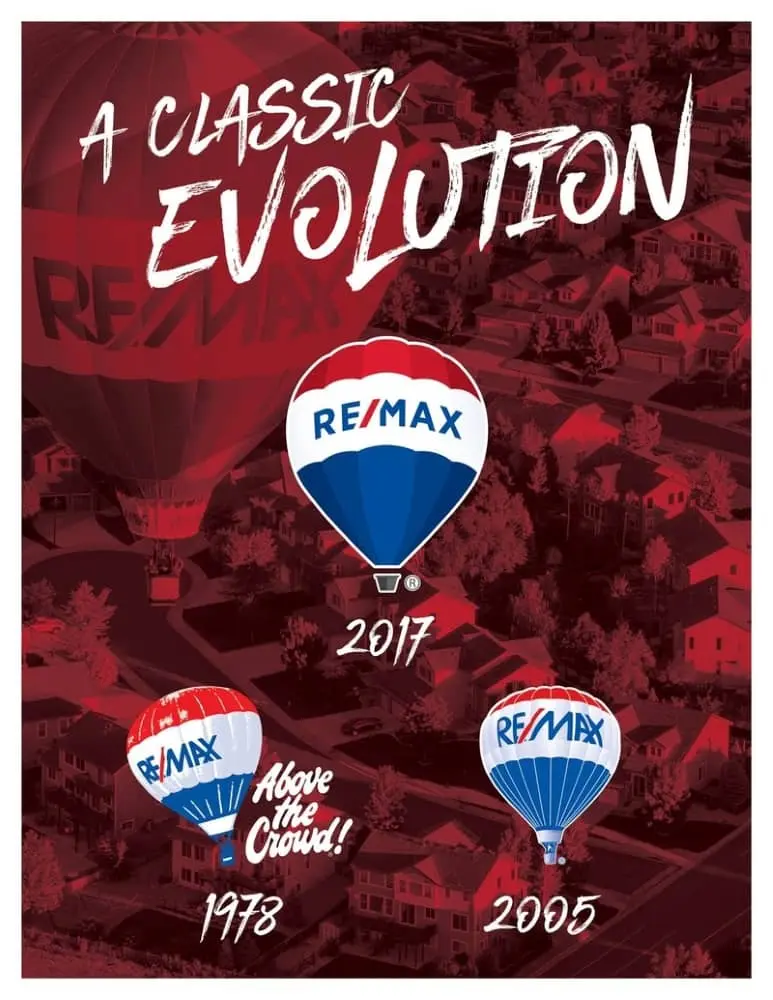
Rebranding is risky business. There’s so many ways for it to go wrong, and we’ve all seen it happen — Tropicana without the orange and Gap with its one pixel of color. (Here at Lucidpress, these make for great lunch table discussions on brand consistency.) But sometimes a gentle refresh propels a brand into the next couple generations.
Before 2017, RE/MAX hadn’t seen a change to its branding in over 40 years. A new logo was in order, one that looked cleaner on a digital screen and represented a modern brand trusted by today’s buyers. Before even going to the drawing table, the brand sent out developers to research what it was about the old brand that made it so iconic and trusted. There’s no sense starting from scratch when certain elements of a brand keep the customers coming back.
The developers took to the streets and surveyed over 20,000 people. They found three “fan-favorite” elements: the “red on white on blue” color scheme, the famous slash between syllables and the all-caps wordmark.
Backed by consumer research, RE/MAX fearlessly took to the drawing table to refresh its brand design. Anchored by the elements that proved to work already and inspired by modern design, it brought to life its new balloon that is more conducive to digital marketing and online shopping.
Cabo Cribs Logo
If you’re looking to buy property in Cabo, I’ll bet Cabo Cribs’ logo catches your attention.
The logo design is simplistic, but it doesn’t scrimp on the essentials of a good logo. It’s easy to understand, elegant, and has a small graphic that makes it obvious they’re selling homes.

Branding, and especially brand consistency, is important to us here at Lucidpress, and we’ve put a lot of effort into understanding how that resonates with real estate businesses.
To learn more from us and some of the first-rate agencies we’ve been lucky enough to partner with, check out the following resources for tips.
- How Chestnut Park’s managing graphic designer used Lucidpress templates to elevate the brand, reduce design turnaround times, streamline communication and retain agents.
- Should you hire a real estate marketing agency? – We asked real estate branding experts how to identify the right time to hire an agency and what you should be looking out for when you do.
- Guide to real estate marketing automation — Does the term “marketing automation” make your eyes glaze over in boredom? We break down this powerful concept in plain English, so you can decide if marketing automation software is right for your brokerage.
Learn how to elevate your brand and ensure consistency with this free guide to real estate branding.
Looking for a quick guide to relationship marketing? You’ve come to the right place. If you’ve landed here, you’re most likely hoping for a little extra info on what is relationship marketing and how it can help you start to either generate more leads or get customers coming back.
Below, you’ll find a nifty guide outlining what relationship marketing is, a few pretty awesome relationship marketing examples and some quick and easy strategies to help you get started — beginning with the basics.
What is relationship marketing?
Relationship marketing aims to build and maintain personal connections with your customers leading to more business whether through word-of-mouth promotion or effective content strategy.
Relationship marketing is a part of customer relationship management (CRM), focusing on long-term customer engagement and customer loyalty.
Individual sales and customer acquisition are simply byproducts of a successful relationship marketing strategy. Instead, focus on your customers’ interests and needs and encourage meaningful engagement. This way, you create the necessary relationships to make more sales over an extended period of time.
Additionally, relationship marketing’s ability to keep you in close contact with customers loops you in on how they use your products and services — which should influence any changes you make. Relationship marketing not only helps you measure marketing effectiveness, but it ensures you stay connected with customers, and according to Gallup, fully engaged customers will spend nearly 23% more than the average Joe Schmoe.
Relationship marketing examples
To give you some ideas on how to heat up with your relationship marketing, we’ve highlighted some pretty cool (in our humble opinion) relationship marketing examples. Be sure to pay attention to how these brands took things up a notch and avoided doing the bare minimum.
Moosejaw
Possibly our favorite example of relationship marketing comes from the outdoor apparel company Moosejaw. A customer ordered a hoodie for his girlfriend as a Christmas present, but unfortunately, she broke up with him a few weeks before the holidays. The customer returned the hoodie, asking for a refund and wrote under the reason for return, “girlfriend dumped me.”
A few weeks later, a large package from Moosejaw arrived with a smattering of t-shirts, stickers and a card that read, “We’re sorry your girlfriend broke up with you, we decided to give you a gift.” We can’t imagine a more personalized response in customer service.
Lay’s
Lay’s is a great example of a company that builds customers’ trust in their brand through interactive content. Lay’s annual “Do Us A Flavor” contest asks customers to submit their ideas for new chip flavors. Once the submission window has closed, participants then vote on flavors through social media, with the winning flavor added to Lay’s flavor lineup Oh, and the customer who suggested the winning flavor gets a hefty cash prize.
GE
One strategy for relationship marketing is through content, and GE’s use of content marketing is pretty solid. By conducting extensive research into their customers and what they need — even down to the socioeconomic contexts — GE is able to personalize its content based on specific audiences. For GE, relationship marketing isn’t focused on individual transactions but rather the relationships with customers in each market, therefore setting the stage for valuable marketing investment, especially in countries with lower revenue potential.
BetterCloud
Customer service in itself makes up a huge part of relationship marketing and BetterCloud hits it out of the ballpark with its “proactive support” system flags. By collecting data on how customers use BetterCloud software, along with any errors or struggles they encounter, BetterCloud is able to proactively reach out to affected customers long before a support ticket is submitted.
Zappos
Zappos makes it clear how customers can contact the brand by placing the customer service phone number front and center on their website. When customers call with concerns, representatives do more than simply take care of the problem — they ensure customers feel heard. For instance, one rep has sent baby blankets to parents who had crying children in the background. Another sent flowers to a customer after she tried to return boots bought for her father who passed away before he could wear them. For Zappos, relationship marketing is about reading between the lines and actively listening.
Benefits of customer relationship marketing
Now, these examples are all well and good, but is relationship marketing really worth the time and effort?
Boost in customer retention
Customers who feel that their needs are being met and that they’re also being heard tend to stick around. Going past the basics to keep your customers happy is only ever going to be a lucrative investment.
Increased customer life-time-value
By building a relationship with your customers, you’ll increase not only customer retention rates but also the lifetime value of your customers. Lifetime value measures a customer’s total sales, as well as their loyalty and advocacy of your brand — e.g., customers become brand advocates or ambassadors (influencers) who recommend your products or services to friends, family members or even work colleagues.
Collect and apply feedback
As you collect customer feedback, you wind up creating a data bank to improve your customer marketing in the future. For example, feedback can be incorporated into content marketing to further nurture customer relationships.
Create customer evangelists
Customer evangelists are those customers everyone wants. They regularly purchase from you — recommend your services to friends, family, coworkers, random strangers on the street, offer praise without any financial incentive and so much more. These customers end up being one of your best marketing tools.
Elevated brand trust
If a customer believes in you and trusts you, they’re more likely to forgive mistakes and still stick around. Building a successful relationship marketing campaign to get to this point though is more than just a rewards program, it’s doing that and more.
Types of customer relationship marketing strategies
Achieving effective relationship marketing is pretty simple. In fact, you may already be implementing some of these ideas below. However, we want to highlight how you can utilize these strategies for relationship marketing specifically.
Content marketing
Content marketing generates three times as many leads as paid searches. When used correctly and efficiently, content marketing connects an audience with your brand on an emotional level and equips customers with helpful information, providing value to you and your customer. And by offering useful content regularly, your customers develop a natural interest in your brand.
Customer service
For a moment, forget that you’re the reader — remember a time when you’ve been the customer and needed to contact customer service due to a pressing issue? How important to you was it to get a quick response?
Responding quickly to your customers’ complaints, feedback or questions will show you not only care but that your brand is reliable. Advancements in AI make this a lot easier for businesses with resources like Facebook Messenger bot or ManyChat. Using a pre-programmed chat gives your customers the option of a quick and easy answer (like an FAQ) or to steer them towards the right representative. Add in the aspect of human follow up and you really raise the bar. Customer service is also a great place to generate feedback from customers to aid in content personalization.
Social media
Social media is a treasure trove for customer feedback. Nearly 95% of online adults follow a brand on social media, which can make sifting through customer comments feel daunting, but you surely want to find those golden nuggets! Remember, don’t just use social media as your personal pirate chest. Make sure you’re interacting with customers on social media too. Even something as simple as a “like” or quick response can remind folks that there are real people behind your logo.
Social media is also another opportunity for you to create effective content that strengthens customer relations. For example, if you’re in the B2B sector, keep things professional by focusing on your expertise. Or, if your audience falls within the Millennial age group, you may find using humor goes a long way on just about anything.
Email marketing
Despite what you may hear, email is still an important marketing strategy and shouldn’t be discounted. Emails tend to get more “me-time.” So, while social media can be used to share more “random” pieces of content, emails ideally feature the type of content you want your customers to really notice and focus on (e.g., you launch a new product feature or so forth). Think of emails like the big, creamy Cadbury eggs in a basket full of Easter treats — they’re all yummy to eat, but those eggs are truly satisfying.
Loyalty program
To round out our relationship marketing strategies, let’s talk about loyalty programs. A loyalty program is a real cherry-on-top kind of tactic that \supplements any marketing strategy you currently have in place. It’s a simple way to show customers that you appreciate their business and that you’d love to see them return. A successful customer loyalty program can heighten customer engagement by providing real value. Be sure to outline to your customers how your program works and the benefits included, whether it’s rewarding customers for referrals or racking up points with each purchase made. Offer discounts for feedback and you can even let your rewards programs guide better effective content.
Now that you have an idea of what relationship marketing is, it’s time to establish your own marketing strategy. Know that regardless of which strategy you choose to implement, it’s important to use effective content to draw in your customers and get them coming back for more. But don’t stress if you’re still struggling getting them to engage with your brand, check out our effective content ebook for some great ways to boost your content game.
If you’re working in marketing, you need a content strategy plan. Full stop.
Having a content strategy plan in place is one of the best ways to ensure your content is effective, personalized and organized. It’s possible that you currently have one you’re working with, but is it doing what you really need it to?
If you have a strategy for content creation, it’s wise to periodically give it a once-over to make sure it’s garnering the results you want. So to help you outshine your competition, we’ve outlined content strategy basics, why it’s important and the steps needed to create an effective strategy.
What is content strategy?
A content strategy is a marketing plan that outlines what content you’re going to create and the goals you want it to achieve. Your strategy will include the who, what, where and how of your content so that everyone involved in creating and distributing content is on the same page. A clear content strategy will provide a foundation for all decisions around your content while also providing a means for management and organization of it.
Implementing effective content into your business model can lead to better brand awareness, higher lead generation, strong customer relations and so much more. By creating content, you provide your customers with a content experience that in turn strengthens your rapport and encourages a personalized and meaningful customer experience.
Creating effective content won’t be accomplished in a single day. Whatever resources you end up implementing, focus on content personalization to ensure your content is reaching your audiences in the right way and at the right time.
Oh, and speaking of time — when is the right time to implement a content creation strategy? Generally, always. Your strategy should be an ongoing part of your business, no matter what industry you’re in.
For instance, if you’re in the fashion industry, it’s wise to be present on Instagram. Working in insurance? A blog is a great content channel to utilize since readers often search for topics in your subject area. You may not need to be accessing every content channel, but you should be utilizing the ones that make the most sense for your area of expertise. There will also be times throughout your organization’s lifetime when you hit the gas on your content, like during a rebrand or product/service launch, but there are too many benefits to the customer content experience to not always have it running in some form.
Content strategy as a product
Content impacts so many different aspects of your business, from lead generation to inbound marketing to brand image and beyond. So what would happen if you treat your content strategy as a product instead of a project?
By understanding content as project-based, you limit those involved and even the potential growth it could have. By fitting your content strategy into your business model just as you would any other product or service, you’re setting yourself up for real growth. Flipping your view of content from project to product is simple: consider each channel you post content to as a product, and then go from there as you “build” and “launch” your content product.
Content strategy is for everyone
Everyone in your organization should know what your content marketing strategy is. By offering access to your content strategy, you’ll lower the risk of off-brand creations and duplicate efforts.
When your content strategy is available to all, you also make sure everyone is on the same page and working towards the same goals. However, you don’t need to share absolutely everything with everyone if they’re not stakeholders. A targeted summary will work, and in other situations, you can simply offer content templates.
Of course, you may need to have someone in charge of your content strategy, like a dedicated content strategist. A content strategist will need to be proficient in copywriting, content presentation, delivery, campaign experience, multitasking and organization, content monetization, and traditional leadership skills.
Your content strategist will be the one implementing your content strategy on a day-to-day basis through their work with C-level execs down to junior copywriters. Hiring someone into this position isn’t the only option though. Through proper content management (e.g., editorial calendars, content tools, templates, etc.), everyone promotes your content strategy without requiring one sole person to shoulder the full weight.
Creating a content strategy
A content strategy isn’t one-size-fits-all, and what goes into yours will depend on a few factors. You can create the best content strategy possible for your business by evaluating each of these areas.
Set goals
What’s the point of your content? Why do you want to produce it? Answering this question first will steer the rest of your strategy in the right direction. Before all else, define what you want to accomplish with your content by examining what you stand for and your marketing objectives.
Here are some ideas for goals your content plan may address:
- Building customer loyalty
- Increasing brand awareness
- Supporting customers
- Retaining employees
- Converting leads
- Driving traffic to your site
Your goals will change as your organization grows, so revisit them and assess what needs to change to keep your content plan aligned with your business needs.
Know your target audience
Detail who your content is being produced for and where they’re most likely to consume information. And remember that different types of content can help you reach different audiences. Knowing how each of these groups behaves, their lifestyles, what issues they face and more will guide you towards the right content formats. It’ll also guarantee you’re using the most effective content for that audience.
Do competitive research
Checking in on what your competition is doing can help you see what is working and what isn’t. You may find there’s a gap to fill with something no one else is doing that you believe could work to draw customers in.
Tell your brand story
Your brand story is what makes you unique, and this needs to be highlighted to set you apart from others. Your company probably isn’t the only one out there doing what you’re doing, so why should someone buy from you? What makes you the better option? This is where you need to highlight your strengths and everything that makes you better than the other guys.
Your brand story should influence and guide all of the content you create. For example, at Lucidpress, our brand story focuses on helping businesses put their best foot forward with effective content. All of our content acts as an extension of that, from blog posts about content strategy to advice for creative teams.
Identify content channels
Because content comes in different forms, you’ll need different channels to publish it on. This section will be influenced by your audience, where they spend their time and what formats of content you’ll be using. Here are a few examples of different channels and when they’re best used:
- Homepage: This is your online storefront. What you post here will teach potential customers what your product is and how it benefits them. Your website is best used as a starting point for the buyer’s journey.
- Blog: People seeking information are bound to wind up on a blog. Your blog is an ideal spot for showing off industry knowledge, giving expert advice and offering product tips. You can cast a wide net and appeal to all sorts of people, from current customers to those who’ve never heard of your brand.
- Social media: Social media platforms can be used for paid ads but also for posting your own content on your page. Social media is a great place to show off your brand’s personality and build relationships with current customers.
- Newsletter: Newsletters are beneficial for retaining customers and keeping them engaged with your brand. You can target different audiences to share current news from your industry or upcoming changes or new releases from your product.
- Influencer marketing: Influencers build brand awareness through their word-of-mouth referrals. Influencer endorsements are a great way to drive traffic and generate interest in your brand.
- Pay-per-click ads: Ads are an easy way to get your brand in front of as many audiences as possible. You can use pay-per-click ads on sites your audiences frequent to build brand awareness.
- Forums: Use forums to increase customer loyalty through tech support or even chatting about new ideas. Forums can also be used to generate customer feedback to build customer relations.
- Guest posts: Guest posting can be a useful tactic for building brand awareness, breaking into a new market or getting your product in front of people who haven’t heard of it.
Determine your budget
If you view your content as a product, your current budget is most likely going to change. Just as companies pad traditional production budgets banking on prototypes and trial-and-error periods, it’s a great idea to do the same for your content.
For example, your first content marketing plan may include hosting a regular podcast, but with time you may find this is a flop and need to move on. Will you be prepared to deal with the loss? Or will you continue to maintain something that’s possibly hemorrhaging money? Start with estimates, then determine what you already have at your disposal.
Measure your success
No content creation strategy is complete without a way to measure marketing performance. The best way to measure your performance will be based on your goals. Below are a few ways to determine your metrics.
- Word-of-mouth referrals
- Views, likes, shares and mentions
- Traffic
- Conversions
- Click-to-open rates
- Reduction in support calls or time spent on calls
- Customer retention
- Revenue
Plan your content calendar
A content calendar details what content you’ll be putting out. You can use one big calendar to include all content formats and channels or have individual calendars for each channel (this may help if one channel uses several types of content).
There are several different forms content can take, and which one you use may depend on your topic or area of expertise. Here are the most common types:
- Blog post
- Video
- Social media post
- Infographic
- Whitepapers
- ebooks
- Podcast
- Landing page
- Newsletter
- Case study
Content strategy examples
Your job is to make sure that content conveys the essence of your brand efficiently and effectively. You want your brand not just to be known, but to be memorable.
Here are some proven ways to do just that.
1. Use surveys to tell readers about themselves
There’s a power in data that no amount of convincing copy can match. It’s no wonder, then, that original research is one of the most sought-after forms of content. Compelling data backed by strong market research and insightful analysis is a surefire way to grab an audience’s attention.
Online surveys—via your website, email or social media platforms—are a great way to collect first-hand data from users at little to no cost. By gathering this data, you’re not only laying the foundation for the report you’re building; you’re also getting your users more invested in your brand. Once they tell you things about themselves—what they like and dislike, what they think, what they want—they’re keen to learn more about your brand and whether you can customize products to their liking.
Take subscription retailer JustFab for example. Every customer is quizzed about their style preferences, and a personalized style brochure is created for them based on their inputs.

These personalized recommendations are the secret behind JustFab’s success as a billion-dollar unicorn; at a time when other retailers are faltering.
2. Ceaselessly educate your audience
Rewind back to high school. Was English your favorite subject? If so, I’d bet $20 that you remember your favorite English teacher in vivid detail. Replace English with history, chemistry or whatever your favorite subject might’ve been—you get what I’m saying.
When you learn something new and exciting, you’re likely to remember who taught you about it.
Sharing things that your users love to learn about will attract new customers to your brand like heat-seeking missiles.
From YouTube videos to well-researched whitepapers, the form your educational content takes is entirely up to you and your readers. A detailed step-by-step post (with pictures) is my favorite way to quickly learning something new. As an avid iPhone fan, I turn to Apple forums for news and information on all my iDevices. What these niche sites successfully demonstrate is that you don’t have to burn a hole in your pocket to create great content. In fact, you can record your iPhone screen and turn it into a quick video tutorial of your product.
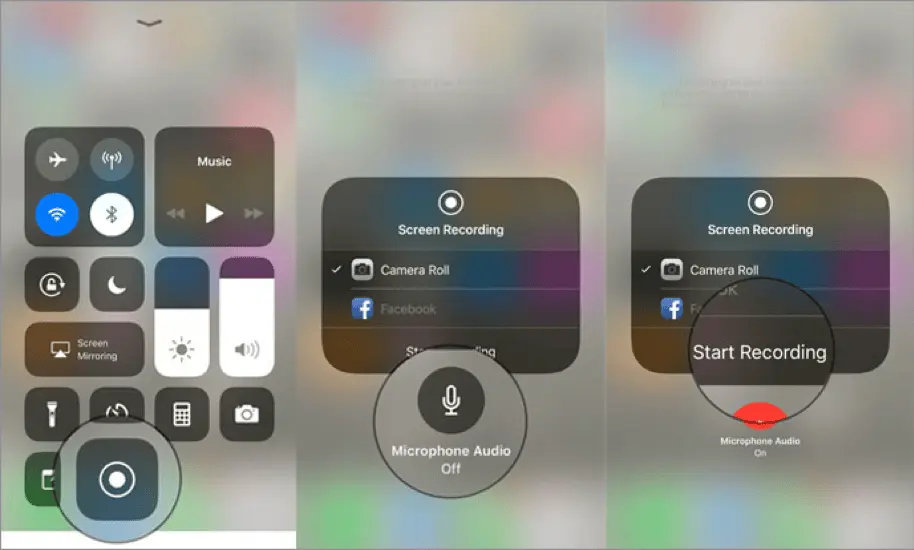
But, it’s not just the format of your content that matters. It’s also the platforms you use to share it on. For example, with the rise of Instagram, it’s easy for me to reach out to my audience with short informational videos that showcase my skills and educate the user.
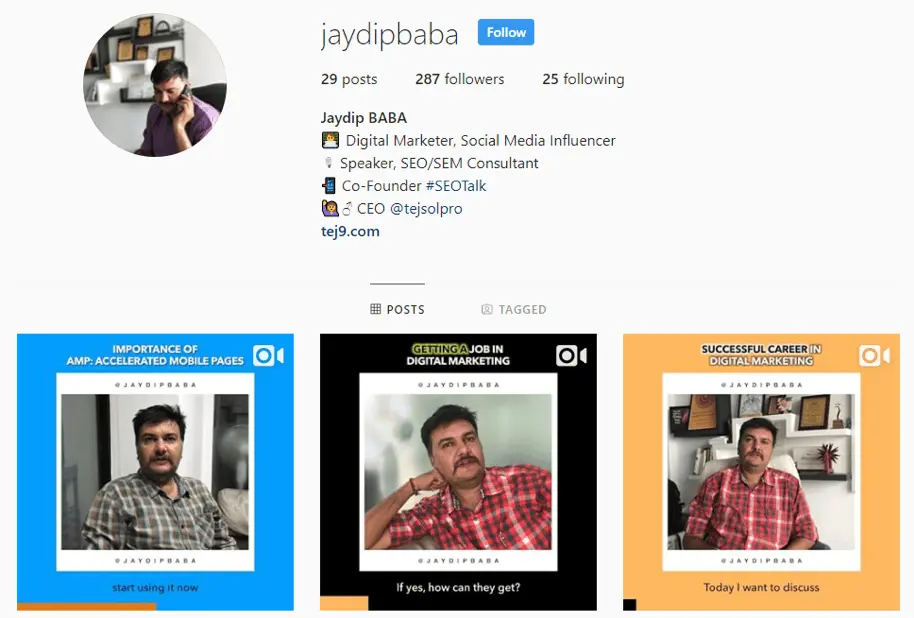
3. Support a cause you believe in
One thing we know about the millennial generation is that they care deeply about causes that matter to them, and they support brands who support those causes. With millennials now wielding the most purchasing power, it’s a good time to dig deep into your brand’s heart and discover the cause that makes it skip a beat.
Specialty retailer BoxLunch is a wonderful example of a brand that lives by its principles. For every $10 you spend with BoxLunch, the company donates one meal to the charity Feeding America.

Mind you, this is not an exercise to start today and forget a few months from now. Consumers can smell fakes a mile away, and your actions go a long way toward building your online reputation. A positive online reputation is the foundation of a strong brand image, which ultimately improves the ROI generated through branding.
For this reason, make sure you pick a cause that truly means something to your company, so it becomes a long-term investment rather than a quick win.
4. Keep in touch with your followers
Each year, brands spend billions of dollars to stay top-of-mind with their target audiences. After all, mind-share equals wallet-share.
But, the best ways to stay top-of-mind have been evolving. From outdoor media, print & television to their digital counterparts, the way consumers connect with brands is changing.
According to a survey by Adobe, 61% of consumers prefer to connect with brands via email. (The next preferred channel? Direct mail.) Audiences love email for its efficiency and capacity for personalization, which makes it feel like the message was directly meant for them.
Social media can also help you stay connected with followers while crafting a brand image that reflects your values. Asking customers to follow you on social media opens up a free, highly engaging channel that they already spend big blocks of time on. And, it offers several benefits that you definitely don’t want to miss out on.
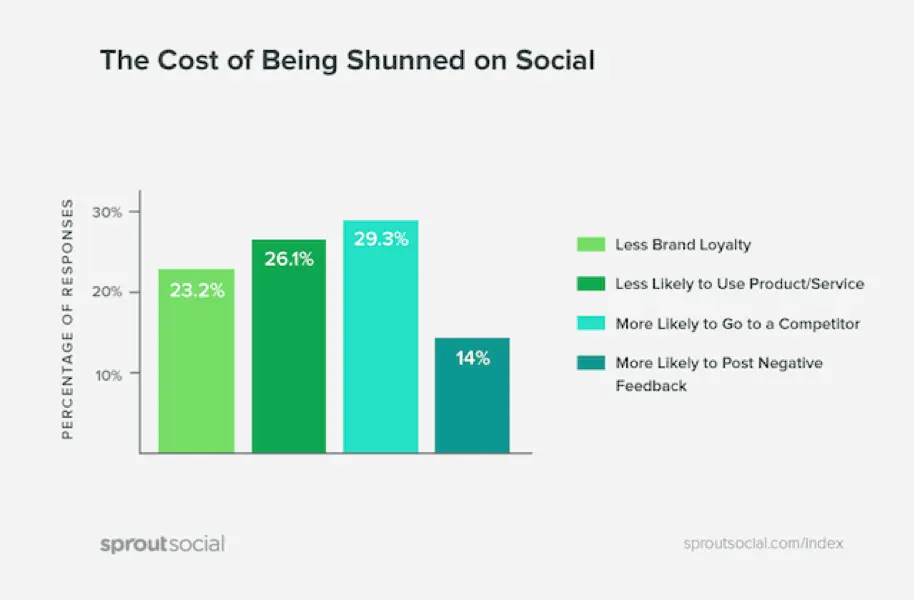
Source: SproutSocial
Beauty brand Glossier features its users on its social channels as a way to build closer bonds with them.
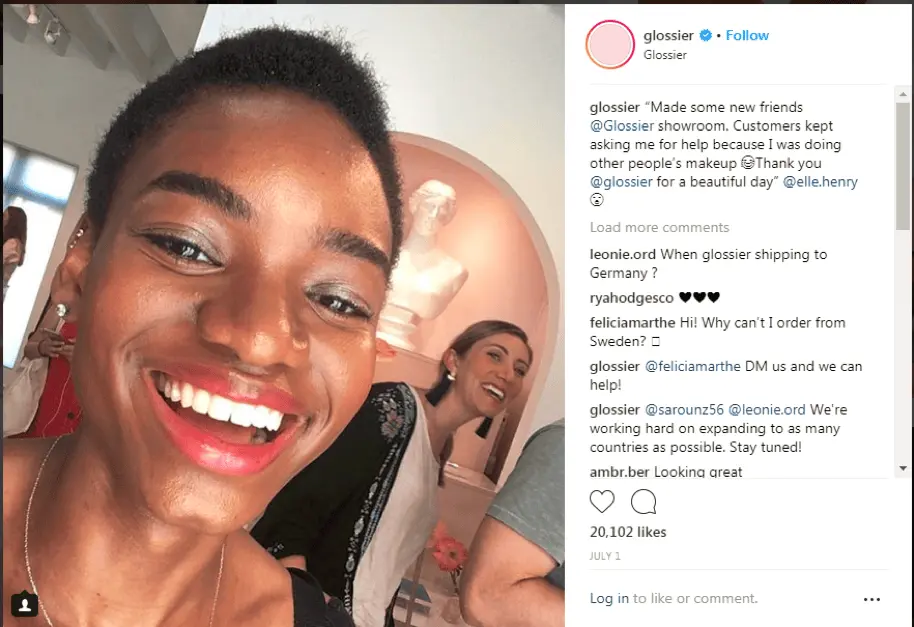
Not only do they share real users using their products (hello, user-generated content!), they also engage each user on a 1:1 basis, bringing their brand into their users’ intimate social circle.
Dig into content management
It’s smart to have a central hub where your content can be found and used quickly. A content marketing platform or management program can help you keep track of the who, what, where, and when of your pieces.
Set up a system where you can create, manage and measure your content all in one place. One bonus to a management system is the ability to keep your content relevant and on-brand through brand templating. Templatized content allows you to lock down brand elements, guaranteeing that brand logos and colors are used properly and not changed willy-nilly. Templatized content also gives you the option of sharing with everyone in your organization, freeing up valuable time for your designers.
As you create your content strategy, you may experience some hiccups along the way, but don’t get discouraged. It’ll take time to get your content and its strategy to where you want it, but each of these steps will build a foundation that you can revisit at any time. And if you need a few ideas on how to create the best content experience for your readers, check out our content experience ebook for more tips.
As patients become more knowledgeable about their own health thanks to the internet and modern medicine, they’re also becoming more savvy healthcare consumers. This evolution means branding in healthcare marketing is taking center stage. A healthcare brand’s digital presence and online reputation are quickly displacing word-of-mouth and local referrals. In fact, research shows that 84% of patients trust online reviews as much as they do personal recommendations.
However, healthcare branding isn’t really about a catchy tagline or a well-designed logo. Medical branding is increasingly a product of how your healthcare organization is perceived in the marketplace and the foothold it has among respected professionals. Whether you invest in cultivating a brand identity or not, your healthcare brand is based on the trust it invokes among patients, doctors, nurses, and other healthcare experts. Here’s why that industry reputation matters and what you can do to develop a better healthcare branding strategy.
Why healthcare branding matters
There are lots of reasons to be intentional about developing your healthcare brand. Below are several that highlight the critical role of branding in healthcare marketing and how it plays into our perceptions about whether a provider is trustworthy, professional, and competent.
Branding in healthcare marketing has changed
The rise of technology in our lives means society is constantly evolving, and the healthcare industry is no exception. The Affordable Care Act has created online healthcare marketplaces that put the consumer front and center. Gone is a healthcare landscape shaped primarily by the limitations of insurance providers and employers. It has been replaced by an online environment where healthcare consumers have a wealth of knowledge and patient reviews at their fingertips.
The healthcare marketing space is highly competitive
A radical shift has taken place in the health industry that has moved the focus from treatment of disease to prevention and testing. This trend opens up many new avenues of healthcare services for both patients and providers. Competition in the healthcare space is fierce, with a growing emphasis on patient satisfaction and health brands that sell directly to consumers rather than through providers. This evolution in care means medical branding needs to catch up, especially in digital marketplaces.
Patients have more choices in the health industry
While location and insurance providers used to shape a vast majority of healthcare decisions, consumers now have more options. This means that catering to the customer and paying attention to the reputation of your health brand is an integral part of any healthcare marketing strategy. Research shows consumers are increasingly weighing the delicate balance between cost and provider reputation versus simply accepting whatever provider is closest and in-network.
Medical branding is about establishing trust
Perhaps more than any other industry, healthcare organizations build value into their brands by establishing trust and practicing transparency. This can be communicated not only through being transparent about the costs associated with care but also via healthcare marketing and branding. Each and every piece of a branding strategy, from the professionalism of marketing assets to the way your organization supports patients on social media, can contribute to this perception of public trust.
6 steps to better healthcare branding
Looking to create a more confident and consistent healthcare brand strategy? Following these steps can set you on the right path to building a healthcare brand that fosters patient trust and inspires confidence.
Study the healthcare marketing competition
To better position your healthcare brand in the marketplace, it makes sense to study the competition. Take in the healthcare industry landscape and study what successful health brands do to differentiate themselves. Note whether they pursue marketing strategies like patient loyalty programs, community service campaigns, and partnerships with other providers.
Some companies that are household names like CVS or Cigna have a different patient base, so study medical professionals and practices that offer the same services or products. Read reviews and check out social media platforms to glean insights about how they’re connecting with healthcare consumers. Look for ways in which you might leverage technology, including apps and telemedicine, to capitalize on market insights and better meet patient needs.
Articulate your healthcare brand story
Your healthcare brand is more than whatever logo or tagline makes it to your website or on pamphlets. A brand identity is the story patients and providers tell about you whether they’re at a private practice, at local hospitals, or online. If you haven’t been intentional about creating a healthcare brand story, chances are consumers have already begun to shape one for you. Look online and take stock of your brand identity and identify what you’d like to change.
You can take control of the narrative by deciding what your healthcare brand story is and how to articulate it. Focus not only on the elements of your visual identity that define your brand identity but also how the content you share communicates what matters to you. Stories are about creating connections with your audience, so carefully consider where your brand storytelling takes place. Even baby boomers, who are the most likely demographic to consume healthcare services, report their lives are shaped by daily social media use.
Develop a healthcare brand strategy
Your healthcare branding strategy should be one that helps you stand out in a competitive marketplace. To cut through the noise in the industry’s busy marketplace, it’s essential to hone your healthcare marketing message. That means considering every element of what you do, from patient outreach to patient follow-up, and asking yourself one very critical question. Does this marketing effectively communicate our healthcare brand and identity?
Because trust and professionalism are crucial to success in the healthcare industry, it’s also important that your marketing assets are consistent and high quality. Lackluster design and sloppy content on your website or social media channels could create the impression the medical services you offer are equally haphazard. Lucidpress can help with brand templates that make it easy for hospitals, clinics, and medical practices to design professional-looking branded content.
Lean into your health expertise
It used to be that medical practices and hospitals acquired patients as a matter of practicality either because of insurance coverage or a location that was convenient. Increasingly, patients look for healthcare providers that are best in class, even if it means they have to travel a little farther or pay a little more. Take, for instance, the success of the Mayo Clinic in capitalizing on its reputation for excellence and using that to catapult its online presence through expert content.
Lean into what you do best and let the professionals in your practice shine. Look for ways to feature educational content, engaging videos, and interviews on your website or social media. Consider partnering with other high-profile, reliable publications. Getting featured in medical journals and magazines produces an enticing bonus because it creates backlinks to your website and can be a boon for your online search ratings.
Focus on the patient journey
Shaping your healthcare branding around the patient experience can be a powerful way to communicate priorities and market your practice. Focusing on the patient journey starts with prospective patients and encompasses every step of their healthcare decisions. Making the patient experience a touchstone of your healthcare branding strategy means listening carefully and committing to putting healthcare consumer needs first.
Consider how your healthcare brand handles not only the services or products you provide but also how you conduct outreach to prospective patients and follow up with current ones. Every step of that journey is an opportunity to provide a personalized touch and a seamless experience from the moment they stumble across you online to the time they spend healing at home. Your healthcare brand has the chance to build a world-class reputation that speaks not only to the quality of the services you provide but the medical professionals you employ.
Every member of your organization is a brand ambassador
High-profile stakeholders like board members or prominent physicians may be the public face of your healthcare marketing campaign. But every employee from the social media manager to the clinic receptionist and even former patients are potential ambassadors for your healthcare brand.
Whether these team members connect with patients online or in person, they are your brand’s most powerful advocates. It’s helpful if they walk the talk and are on the same page when it comes to your brand story and marketing strategy. And it’s imperative everyone in your organization understands that every interaction during the patient journey has the potential to make or break your brand reputation.
The current healthcare landscape may be competitive, but within all that bustle and noise is an opportunity to empower patients and create better-informed healthcare consumers. Building a dynamic, thoughtful digital healthcare brand can capitalize on that unique opportunity and establish stronger connections of trust and transparency between healthcare providers, healthcare consumers, and the communities they serve.
Once upon a time, conversations about education revolved around the needs of millennials, but Generation Z college students have arrived and with them the potential to reshape the four-year experience. Gen Z learners are those born after 1996, and they are the cohort currently graduating from high school and facing decisions about investing in a college experience.
Like previous generations, Gen Z students have specific needs and learning preferences shaped by evolving societal expectations and technology advancements. We’ll take a closer look at the characteristics of Generation Z students and how those factors influence not just today’s four-year degree programs but tomorrow’s college marketing and recruitment strategies.
How Generation Z college students are different
Perceptions of each generation are too often shaped by cliches, and Generation Z students are no different. The suggestion that Generation Z is addicted to their smartphones, reliant on social media, and dependent on their parents will sound eerily familiar to millennials. While age groups aren’t monoliths, certain demographics and trends can get beyond cliches to tell us about the unique challenges Generation Z students face.
Generation Z college cohorts are more diverse than their predecessors
Nearly half of post-millennial students are racial or ethnic minorities, and by 2026, it’s expected the next generation will be a majority of non-white students. Currently, one out of every four Gen Z students are Hispanic, followed by 14% who are Black and 6% who are Asian. Today’s college students are also more likely to hail from urban areas and be more well-educated than their predecessors.
Like millennials, Generation Z college students live with their parents
During the pandemic, it was widely reported that a majority of young adults were living with their parents. In truth, this is a trend that presented itself before coronavirus and has stayed consistent from millennials through Generation Z. Today’s college-age students are more likely to live with their parents and for longer stretches than previous generations.
Generation Z students grew up entirely in the age of the internet
The internet has shaped our lives in profound ways, but perhaps none have felt the effects as much as Generation Z. They were born as the world wide web and smartphones were truly becoming ubiquitous and have lived their entire lives with modern technology. Social media specifically is the cornerstone of how they communicate and forge relationships.
Generation Z students are more likely to report mental health concerns
A 2018 report from the American Psychology Association raised the alarm that only 45% of Generation Z students reported themselves to be in good or excellent mental health compared with 56% of millenials. Primary stressors for Generation Z included mass shootings, suicide rates and climate change. It’s certain the health concerns and economic challenges of the pandemic have only added to this Pandora’s box of worries.
Generation Z students have specific learning preferences
The characteristics that define Generation Z college students have driven a set of specific learning preferences. Understanding how these students prefer to learn and what environments they thrive in can help inform both college recruitment strategy and a better college experience.
Generation Z college students are pragmatic
As tuition costs rise, both students and their parents are worried that degrees don’t hold the same value they did for previous generations. In the face of mounting student loan debt, Generation Z college students want to make sure their college pays off as an investment by focusing on the acquisition of practical, career-focused learning.
Modern college students expect flexible learning models
You’d assume that the newest generation of college students who cut their teeth on YouTube would lean into virtual education. However, surveys indicate Generation Z college students are skeptical that remote learning can provide what they need to succeed in the workplace. Increasingly, Gen Z students prefer hybrid models that combine world-class online learning environments with in-person engagement.
Generation Z wants to move at their own pace
While the latest generation of college students is quite comfortable with virtual learning, they prefer opportunities for independent work, project-based learning and a self-paced curriculum. Accustomed to having a wealth of knowledge at their fingertips, Generation Z college students are more focused on acquiring the soft skills that employers view as increasingly essential.
How to adapt education for Generation Z college students
Attracting Generation Z college students isn’t just about updating your university branding and getting visibility on social media channels. It’s also about carefully considering the challenges Generation Z college students face and how you can support them with a better four-year degree experience.
Get serious about community and inclusion
The diversity of Generation Z demands that educational institutions invest extra effort in creating an inclusive and welcoming environment. If you want today’s college students to call your campus home, communicate support and devote resources to establishing safe communities for racial and ethnic minorities as well as LGBTQ populations. Generation Z is full of seasoned activists who believe there are no shortcuts to being a trusted ally, so be prepared to do the work.
Build more value into degree programs
Selling Generation Z college students on the burden of student loans means providing more bang for the buck in a four-year experience. Think expanding internship opportunities, career placement services, and classes that provide plenty of hands-on learning experience. A network of engaged alumni can also help students get their foot in the door of that dream job.
Diversify the learning model
The pandemic drove many education institutions to expand remote learning. Now that the virtual infrastructure exists, colleges should use it to develop better hybrid-learning models that blend remote, in-person and experimental classes into a flexible learning model Generation Z students will appreciate.
Support services are crucial
Generation Z students need more support services than many campuses provide. College budgets should invest in expanding mental health services and offering holistic wellness programs that benefit students both in-person and at a distance. Considering how to better support mental health and wellness in high-stress degree programs is also a must.
Graduate to better, more immersive technology
Speaking of budgets, limping along on last year’s tech isn’t going to cut it with Generation Z. Start investing in virtual reality, esports communities, and learning spaces designed to accommodate immersive experiences. Generation Z college students are mobile. Make sure your technology can keep up.
Give Gen Z’s parents more opportunities for involvement
Generation Z increasingly lives at home with their parents, so leverage those relationships to form a system of support for students and create a healthier college community. While it may pose some challenges for colleges up-front, studies show the long-term payoff on parental involvement is more stability and a better chance of success for students.
Providing an exceptional four-year experience to Generation Z college students will force educational institutions to navigate a different roadmap than the one used for millennials. But setting aside cliches and approaching the challenges students face with compassion is well worth the effort to recruit the most well-educated and diverse generation of college students in history.
Medical marketing can be challenging in an online environment of huge healthcare conglomerates, but there are some healthcare marketing strategies that can help your practice stand out in a crowd. Despite some of the high advertising costs for medical terms in the digital marketing space, connecting with prospective patients and promoting your practice doesn’t have to be a costly endeavor.
The following healthcare marketing ideas can help you get beyond traditional healthcare advertising and reach referring physicians and new patients who can expand your practice and ensure success in a highly competitive industry.
10 healthcare marketing ideas and strategies
While marketing in healthcare can seem confusing, healthcare marketing trends closely mirror trends in other industries. The following healthcare marketing ideas distill what works in other digital marketing spaces and apply them in ways that can be a huge benefit to your practice.
1. Create educational content for patients and physicians
People use the internet to stay informed about every aspect of their lives, including health and wellness. You can leverage that interest by creating content that speaks to what potential patients might be concerned about. Fortunately, healthcare content that gets clicks such as those listed below doesn’t always require hiring a content marketing agency.
- Blogs or articles: You can feature educational content on your own website or look for opportunities to guest blog or be featured in other online publications. Guest blogging has the built-in bonus of framing you as an expert in the field, and it can bring your practice to the attention of a fresh audience of patients and other physicians. Getting featured on another site also promotes backlinks to your webpage, which can improve SEO (search engine optimization).
- Videos: You may have heard that video is currently king of social media, and healthcare marketing is no exception. Not only does video drive better ranking on Google, but it can elevate your social media profiles and drive engagement in digital marketing channels like YouTube and Facebook. Check out TikTok to see how creating short, easily digestible videos doesn’t have to be rocket science.
2. Know your competition and your healthcare marketing trends
Researching other medical professionals online can offer some insight into how to make your own practice stand out. Make sure the contact information for your practice, clinic or hospital comes up easily in search and is listed in various directories from Yelp to Yahoo and Google. And don’t forget about industry-specific sites like Healthgrades.
Also be aware of what kinds of digital technology your competitors are offering patients. Health apps and telemedicine are leading the digital healthcare revolution, and utilizing these tools can signal to patients and physicians that you’re an industry leader.
3. Smart medical marketing is about keeping it local
One often overlooked component of healthcare marketing is the clear advantage of focusing on local digital marketing campaigns. Most patients prefer not to travel outside their own communities for check-ups and medical procedures, so localized SEO is crucial.
Showing up at the top of the local search results, sometimes referred to as the Google 3-pack, isn’t as easy as claiming your listing on Google. Ranking top of the pack involves citation building, consistently updating your profile, and snagging plenty of those coveted five-star reviews.
4. Cultivate reviews and be responsive on social media
Speaking of reviews, there are few things that drive positive impressions quite like authentic details of a patient experience. And recall that patient experience is more than whatever medical procedure or physician interaction happens. It’s also about how your practice manages patient anxiety, financial details like billing, and a space that supports open communication.
Soliciting patient feedback via surveys and requesting online reviews are all vital healthcare marketing strategies, but remember not to neglect your social media presence. Staying connected with patients means being present in online spaces that they might consider extensions of their community.
5. Develop consistent branding and digital marketing assets
The digital marketing assets you use for healthcare advertising should be consistent, high-quality messaging that conveys your brand. While you might feel confident about your expertise, online users only know what your healthcare marketing strategies communicate. If your healthcare marketing seems outdated or unprofessional, it can suggest the medical services you offer don’t embrace modern medicine.
When it comes to keeping your healthcare marketing messaging consistent, Lucidpress can help. Check out our brand templating platform that can help hospitals and medical practices spend less time designing quality branded content that attracts new patients.
6. Leverage relationships with existing and previous patients
While attracting new patients is often the focus of many medical practices, don’t forget your existing and previous patients can be a goldmine. Not only can retargeting this group to promote services and procedures be an overlooked component of marketing in healthcare, but rewarding those patients for loyalty can lead to increased satisfaction.
Both other physicians and previous patients can be your best sources for referrals, so make sure outreach to this group is a central focus of your healthcare marketing strategies.
7. Put the hospitality in hospital marketing strategies with an open house
Both virtual and in-person open houses can help increase the visibility of your practice and help it become a cornerstone of the community. When someone asks for a referral, you want your practice to be top of mind, even if those in your community haven’t been patients.
Unfortunately, “build it and they will come” isn’t usually how healthcare marketing works. But you can foster a more successful event by offering incentives. Think about how to create connections and leverage relationships with community leaders to encourage participation. Don’t hesitate to offer the traditional incentives people usually enjoy at open houses, such as great food and fun activities for families.
8. Optimize your website to provide a better healthcare marketing experience
You’re trying to market your services, but visitors to your website are probably just trying to find information quickly. A good user experience on your website sets a precedent that you’re a provider that cares about patient support and customer service. Think of your website as the lobby of your practice. Does it reflect how you’d like patients to be greeted and the information you want them to have access to upfront?
Here are a few things to consider when evaluating the user experience on your website.
- Does your website work well on mobile devices?
Going mobile can be tricky, but your website should adjust automatically to accommodate different browsers and devices. It should also have fonts that are easy to scan in sizes that don’t need to be adjusted for mobile viewing.
- How are users coming into your website?
Depending on your ranking in Google and which terms are driving search results, your main page might not be how patients are finding your website. Conduct an audit to determine how users are finding you online and what page they land on when they arrive at your website.
- Does your website load quickly?
Large images and other assets that aren’t optimized can lead to long load times for pages on your site. Think of the effect as similar to that of the waiting room at your clinic or the hospital. If the wait time is too long, patients will simply leave and go elsewhere.
9. Effective communication is one of the best healthcare marketing strategies
When every team member is communicating effectively and consistently, it can drastically improve the patient experience and healthcare outcomes. In fact, communication errors were the root cause of nearly a third of medical malpractice suits, according to a 2016 study from CRICO Strategies.
But overcoming bottlenecks, department silos and other dynamics can often make cleaning up clinic and hospital communication challenging. Leveraging technology to provide channels for two-way consultation, implementing team huddles, templatizing patient communication, and promoting cross-functional collaboration are all solid strategies for improving your clinic or hospital communication.
10. Try a physician liaison
Don’t wait until all else fails to explore an outside perspective. Physician liaisons specialize in growing referral programs and work to help your medical practice make the right connections in the community.
If you don’t have the budget to devote to a formal liaison, identify someone from your healthcare marketing team to work on forging relationships with physicians and beefing up your referral program. A little extra focus on these relationships can pay big dividends in growing your patient base.
Evaluate the return on investment you currently get from healthcare advertising and consider whether exploring one or several of these healthcare marketing ideas could be the right move for your practice. In today’s fast-paced, social media-focused environment, traditional medical marketing approaches may need an update to keep pace in an increasingly competitive industry.
The world’s most memorable brands didn’t build themselves overnight. What today’s juggernauts like Uber and Walmert did do, however, is spend time cultivating their brand identity through consistent messaging, design, customer service, and more. Together, all of these elements form your brand. And as such, it’s important that you control all of these touchpoints. Everything you do sends a message, and as a brand manager or creative lead, it’s up to you to guide and direct what messaging gets the green light. This is where your brand guidelines come in.
At Marq, we’re obsessed with branding, and we like to keep a close eye on what the most recognizeable companies are doing to maintain — and to change — their brands. Lucky for us, a lot of these businesses post their brand guidelines online, giving us an inside look into how they do what they do.
Every brand guideline is unique, but they all share the goal of teaching people how to properly and consistently use the building blocks of a brand’s look, feel, and language. Some stick to these basics, while others give a comprehensive look into a brand’s story, philosophy, inspiration, and positioning statement. Sounds pretty useful, right? It is — and if you want to see how brand guidelines work in the real world, read on to check out some of the best brand books we’ve encountered yet.
Sounds pretty useful, right? It is — and if you want to see how brand guidelines work in the real world, read on to check out some of the best brand books we’ve encountered yet.
What are brand guidelines?
We like to think of brand guidelines as a instruction manual of sorts for keeping your brand’s positioning, communications, and experience consistent. With it, anyone should be able to craft on-brand content and self-serve any creative requests they might find thrown their way.
If we were to whip up a brand book example on the spot, it’d likely include things like:
- Logos – full and secondary logos, along with any icons
- Color palette – primary, secondary, and any tertiary colors
- Typography – primary and secondary fonts, sizes, and spacing
- Imagery – graphics, artwork, photography, etc
- Brand voice – your brand’s POV, how it relates to your audience, what kind of language you use/avoid
A frequently updated and easily accessible brand standards guide will go a long way in making sure no one at your company is making off-brand collateral. If everyone knows how and where to find your brand guidelines, they can just quickly pop in and check the rules without needing to ask a designer or risk publishing something that doesn’t look or feel like your brand.
And with that being said, below are some of our favorite brand guideline examples.
Great brand guidelines to inspire your team
Skype

We love that Skype’s brilliant brand book reads more like a cheeky comic than a stodgy brand style guide. Illustrations and speech bubbles are used throughout to convey exactly what vibe the brand is going for, and it’s a testament to what good creative can do for your branding. It’s fun to read, it’s colorful, it’s got jokes — what more could you want? When you need inspiration for adding fun into your brand, consider spending some time with Skype’s branding guidelines. View the full brand guidelines here.
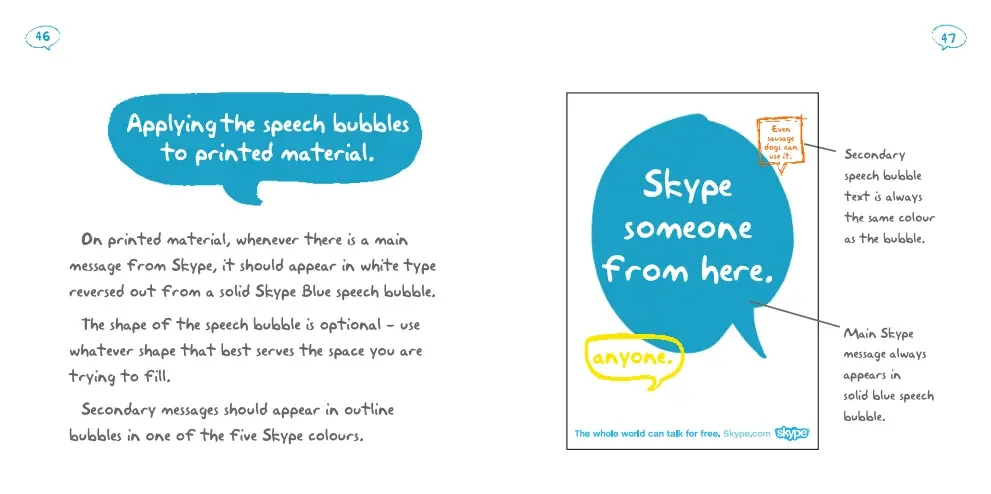
Mailchimp
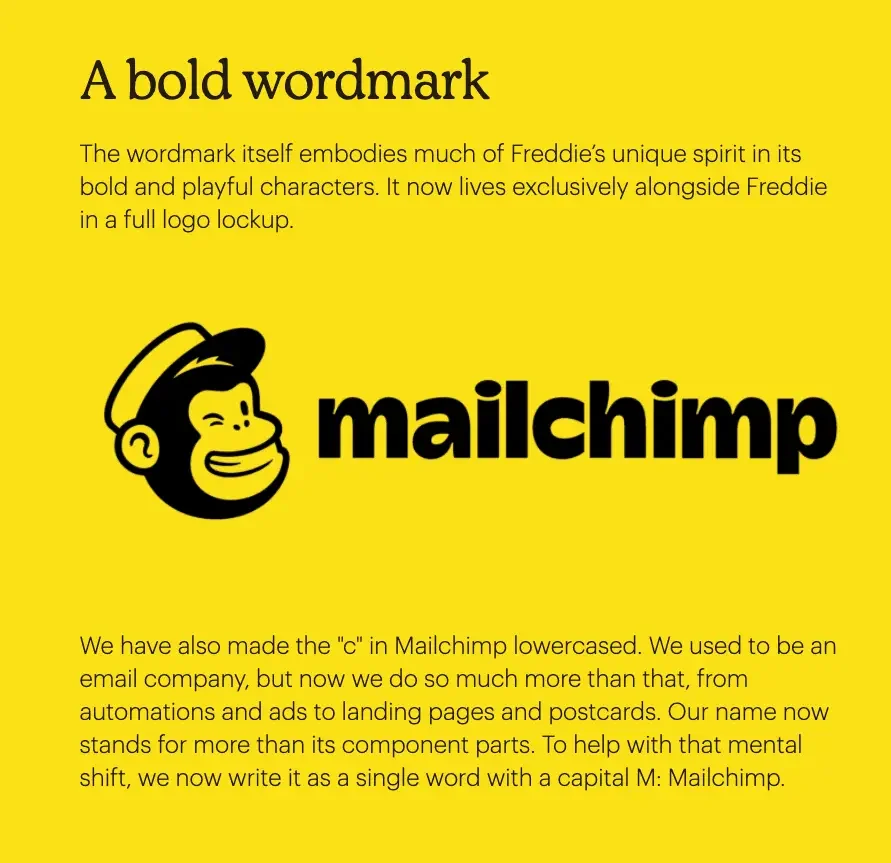
Our favorite small-business-focused marketing platform got a new look in 2018 that’s still serving the brand well today. The brand offers both a peek at the visual style guide as well as an in-depth content style guide. Everything from the brand’s colors to tone to animation style relies on vibrancy and simplicity, and we couldn’t be bigger fans.
Scrolling through the style guide, you’ll see that the thought behind Mailchimp’s brand is well articulated and laid out. You’ll always find a “why” here. It’s a simple thing, but this really helps people understand the vision for the company, which in addition to laying out ground rules, is one of the most important things brand guidelines can do.
“Think of your brand style guide as a living document,” Mailchimp Art Director Jane Song says. “You want to give your brand expression room to keep expanding over time.” View the full brand guidelines here.
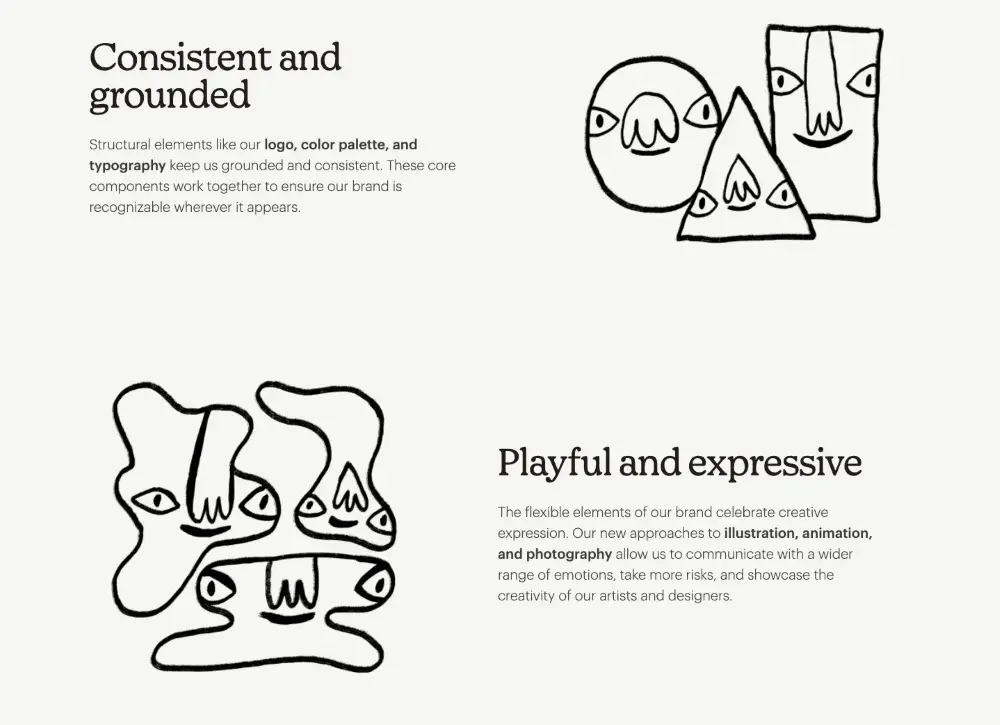
Why they work: Mailchimp and Skype’s brand guidelines manage to strike the perfect balance between fun and pragmatism. It’s easy to see exactly what makes these companies unique, but the cheeky designs and charisma never overshadow these guides’ true purpose: to educate and inspire.
Boy Scouts of America
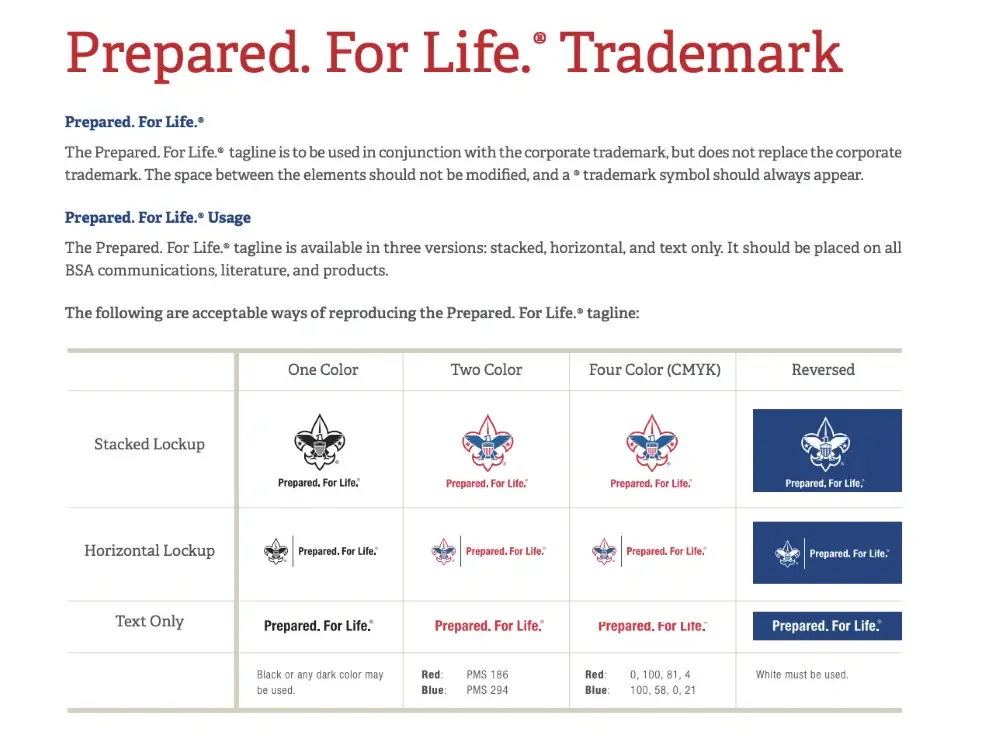
The Boy Scouts of America have a huge branding challenge: The organization needs a brand guideline that not only conveys its message (“Prepared. For Life.”) but also allows for the customization of the brand in literally hundreds of thousands of troops. Just for perspective, there are over a million scouts in America plus more than 800,000 adult leaders, and any of those leaders might want to make a flyer or poster or brochure.
Most of these volunteers don’t have graphic design experience, and that means corporate needs a clear, easy to use, and accessible set of brand guidelines. That’s why BSA’s brand book offers a lot of hand-holding, as it might be the only brand manual these volunteers will ever see. There’s more to this manual than just guidelines about font size and color palette, though. The book carefully explains marketing terms that the average scoutmaster or den mother might not be familiar with. And for each logo and trademark asset, there are ample do’s and don’ts to advise the layman on how to move forward.
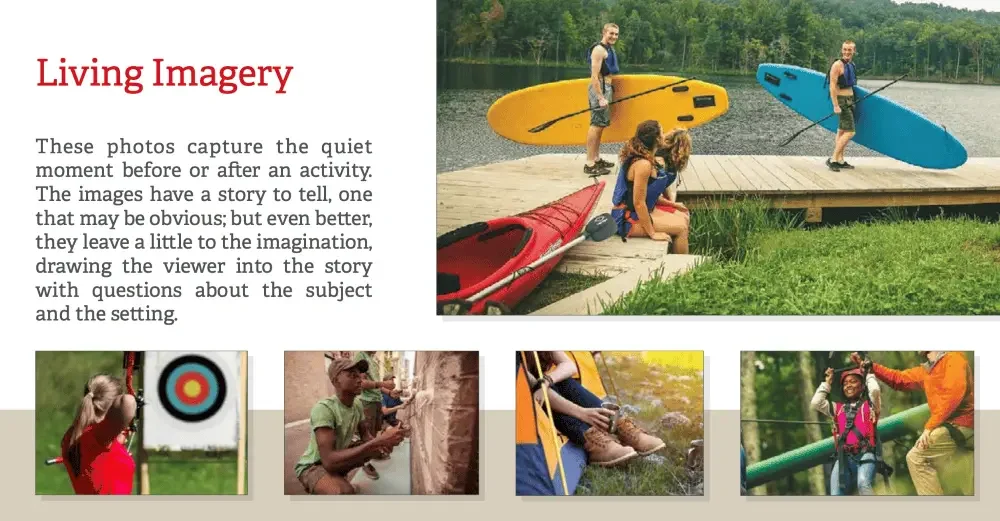
These brand guidelines, which are built upon a rich tradition of imagery, slogans, and trademarks, are a perfect example of how an organization with many products and variations can clearly and succinctly build a cohesive brand platform that integrates common design elements into disparate categories of symbolism. View the full brand guidelines here.
Girl Scouts of America
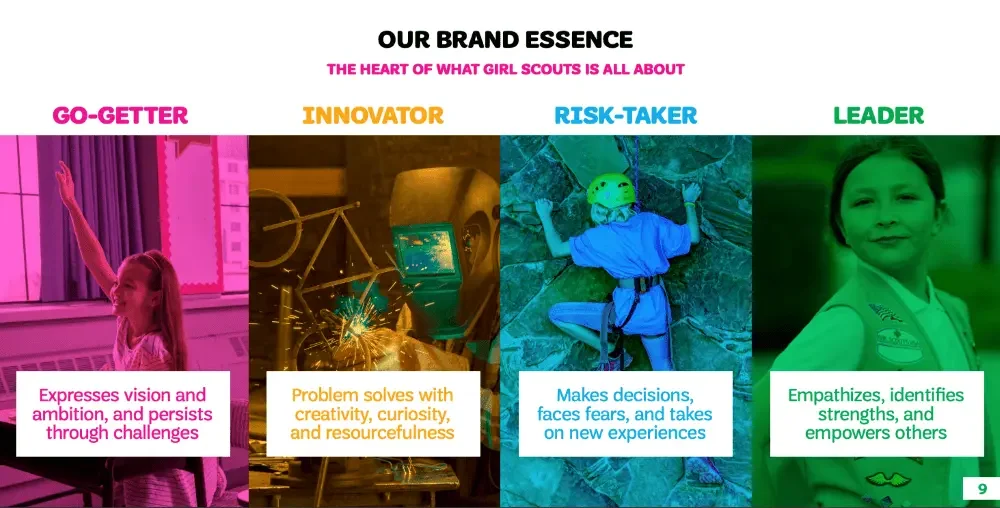
We got our hands on Girl Scouts of America’s brand playbook, which differs from a traditional brand guideline in that it’s focused on the high-level messaging of the brand rather than design details. It’s a stellar opportunity to see how a sprawling organization with thousands of chapters all over the country maintains a consistent brand identity.
The brand book’s specific purpose is to “help you understand how Girl Scouts functions as a brand and the key differences that set us apart from the rest of the saturated ‘girl power’ marketplace.” Look no further if you want to find out how a legacy brand tackles differentiation and keeping up with the times.

Inside you’ll find plenty of ideas on how to relay your mission, brand story, values, and voice and tone. View the full brand guide here.
Why they work: With a 100 year+ legacy and thousands of public members, the BSA and GSA face a unique challenge in upholding brand consistency at every level of their organizations. By prioritizing clear, concise, and down-to-earth instructions, they’ve made sure that anyone can take their brand and run with it.
Walmart

Walmart has a separate brand guideline just for internal comms and marketing. The guide pays special attention to voice and tone, encouraging human, but not chummy, language: “We have a specific approach that captures our fresh, always-Walmart spirit.” The brand’s Associate Spark logo is designed to represent the various people, cultures, and careers across the Walmart brand.

This brand guideline example is a smart look at how a huge company takes its company culture seriously and works to maintain a good employee experience. View the brand guide here.

This tech giant has a hundred fingers in a hundred pies, which is exactly why we’re so interested in this case study of Google’s Logo, the Google G, and the Dots. The new logotype is imbued with “childlike simplicity” (a Google video shows the new logo being written as though it was on a grammar school’s middle-lined paper). It’s mathematical – an ode to geometry. What’s more, it was designed not only for a new brand aesthetic, but also to scale up and down while looking the same across many platforms — a problem Google’s previous logo struggled with.
Not to be outdone is the simple Google G: a circle with a small cut taken out and a reformed horizontal. It is designed for small applications where the full logotype wouldn’t have room to appear, but they’ve made it similar in many ways. The G is essentially the new G from “Google,” but with a thicker line weight, and it incorporates all the colors from the full word. It’s instantly recognizable as being the younger sibling of the full logotype.
Finally, Google introduced the dots, which are referred to as “a dynamic and perpetually moving state of the logo.” The dots are emotive: gently rolling when awaiting a command, expanding when being spoken to, forming a turning circle when thinking, and so on. The colors of the four dots are the same as the colors of the logotype and the Google G: blue, green, yellow, and red. View the full brand guidelines here.
Why they work: As giants of tech and commerce, Google and Walmart’s branding stretches far and wide. As such, they need a set of flexible brand guidelines that can not only adapt to different applications, but can still be instantly recognizeable at a glance.
Slack
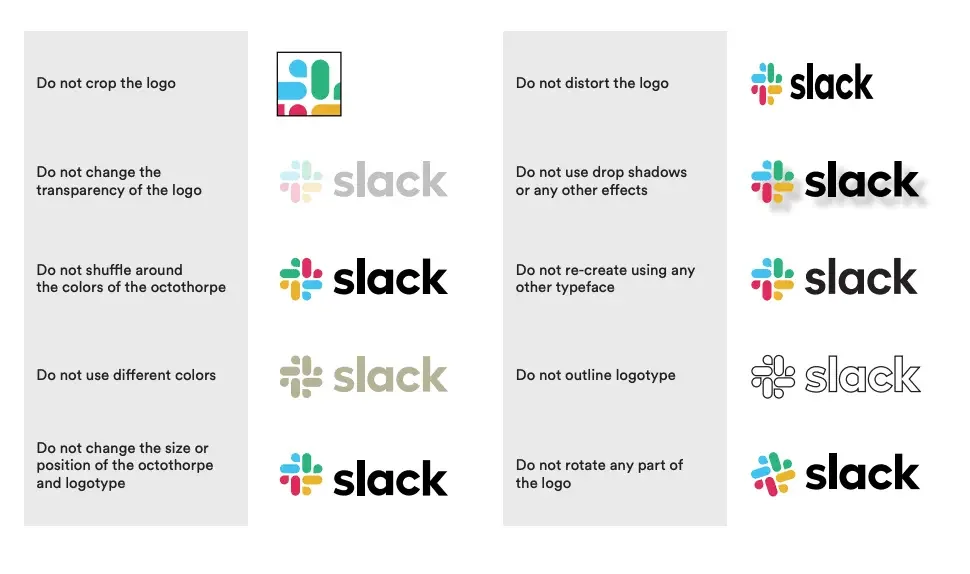
You can check out Slack’s brand guidelines to see how this instant-messaging giant lays down the brand law. We appreciate how the brand book is designed to be as clear and user-friendly as the platform itself. It walks you through all the fine details of colors, icons, trademarks — the works.
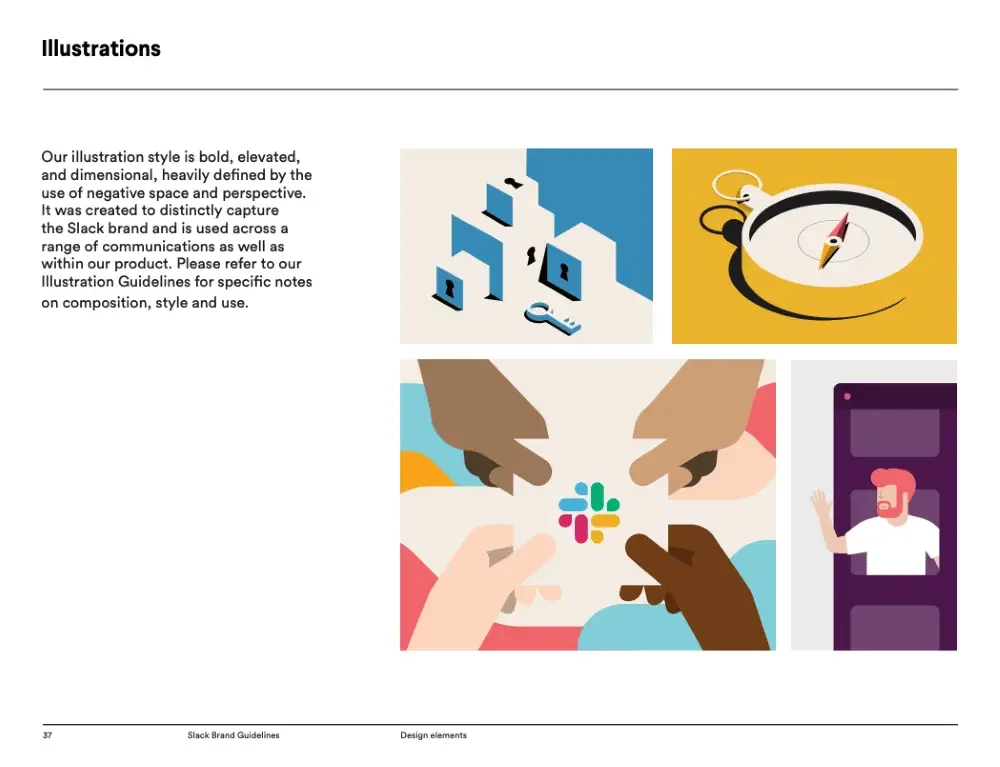
This particular brand book starts by taking you through its values (empathy, courtesy, craftsmanship, playfulness, solidarity, and thriving) before moving you through a thorough discussion of color, type usage, and logo lockups. This brand guideline example has it all, including type adjustments for its international markets and rules for photography and videos. View the full brand guidelines here.
Uber
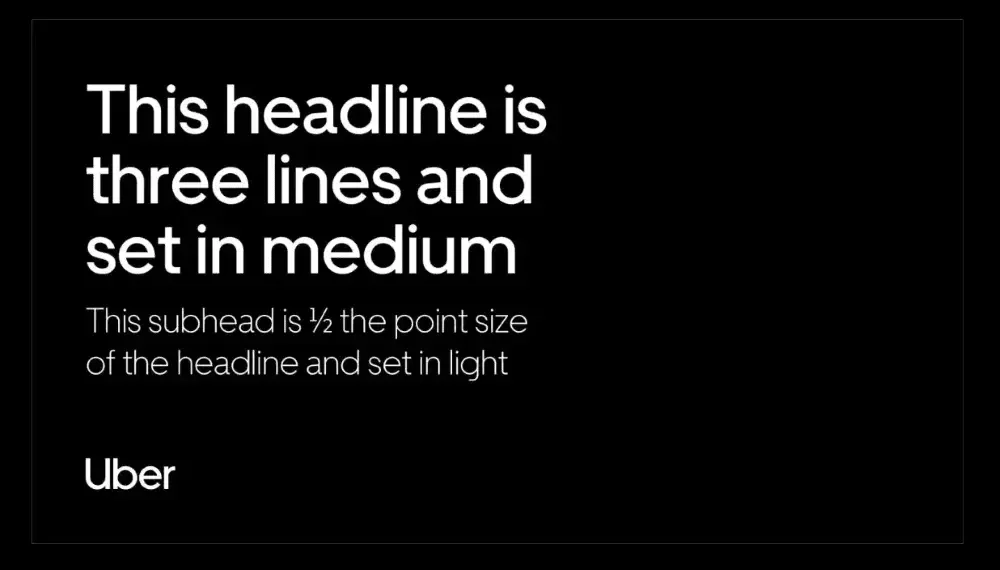
We love Uber’s very tidy brand guideline, divided into neat compartments like logo, color, composition, iconography, and illustration. It’s presented as an interactive webpage rather than a digital book, and this approach allows plenty of space to hash out details. You can even download templates and assets directly from each section, making the guide a functional DAM of sorts as well. View the brand guidelines here.
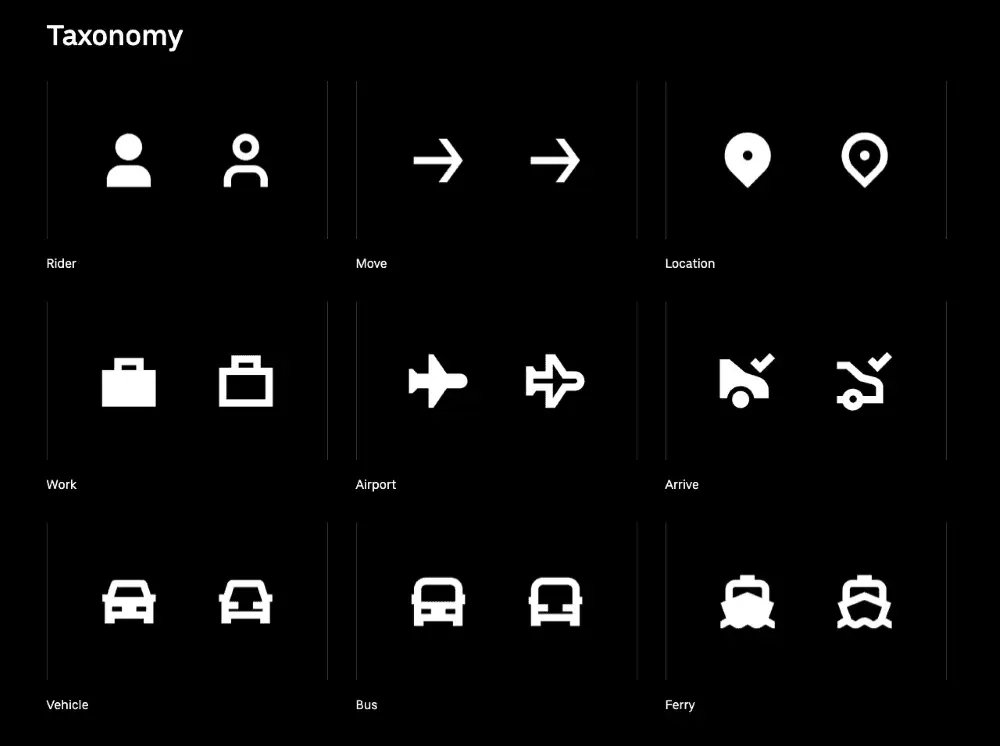
Why they work: Sometimes simplicity is the best thing you can give your creative teams. We appreciate Slack and Uber’s no-fluff approach, and love how easy Uber’s brand book makes it to download templates and assets.
We hope these brand guideline examples inspire you to imagine all of the things your own brand guidelines can do for your company. While the idea of a brand book might seem restrictive at first, the reality is that a good set of brand guidelines will help you tell a compelling story and create a character for your company. They’ll help you remember exactly what you’re all about, and help your customers understand you better.
Have your organization’s social media platforms gone radio silent since the intern left? Welcome to the world of social media strategy for nonprofits where the struggle to post consistently is real. Nonprofits rely on an army of volunteers and don’t always have the financial bandwidth to staff an office. This bootstrapped approach means social media marketing for nonprofits can become an afterthought.
Like gardens, social media channels languish unattended. Following the social media best practices for nonprofits listed below is a great place to start building a social media nonprofit marketing strategy or to revive an existing one. In each tip, you’ll find insight on how to use social media for nonprofits from social media managers and CEOs who know what it takes to engage successfully.
7 tips on running social media for nonprofits
1. Go where your audience is
You can’t be all things to all people. Part of a successful social media strategy for nonprofits is to think about where your audience is spending time. Focus your efforts on the social media platforms that potential donors are most likely to use either personally or professionally.
Whether it’s the eye candy on Instagram or the younger crowd on TikTok, focus on the platform your audience calls home. And keep in mind it might not be Facebook.
“I think nonprofits benefit from being on LinkedIn so that they can be found easily. It adds credibility and transparency when you know the people you are meeting or working with know people in common. LinkedIn has become more than an online rolodex — it is the foundation for building trusted relationships in the digital economy.”
Paige Arnof-Fenn, Founder & CEO of Mavens & Moguls
2. Post with a purpose
Starting with the purpose in mind is a key part of social media best practices for nonprofits. If your timeline hasn’t seen much action in a while, posting a flurry of updates won’t produce engagement. Instead, develop a strategy for each platform that considers how your content can have the most impact.
Think carefully not just about social media best practices for nonprofits but also about your organization’s goals. What do you want to accomplish? Get specific. If the purpose of your social media strategy is to gain more followers, connect to your why. There’s a reason that’s important to social media marketing for nonprofits. Consider what success looks like, whether that’s increases in nonprofit fundraising or recruiting more volunteers.
3. Get consistent across channels
In social media, consistency is about more than posting at the same time every day. Cracking the formula for how to use social media for nonprofits requires both the right amount of engagement and keeping content streamlined across different channels. It’s about frequency, timing, and a dash of experimentation to determine what works for you and your audience.
If that sounds a little daunting, don’t despair. Julia Sellers from Thirty Press, a communications consultancy for nonprofits, advises falling back on the 80/20 rule, which is one of several social media best practices for nonprofits.
“Posts should follow the 80/20 rule. 80% education and inspiration versus 20% hard asks for donations. Nonprofits do not have to be on every social platform. Evaluate your target market and get really strong at being present on the one or two platforms where that market intersects.”
4. Find an authentic voice
It can be tempting if you have the financial bandwidth to outsource social media management, but that can be tricky for nonprofits. Social media strategy for nonprofits relies on connecting to the passion people have for a particular cause and turning it into action.
As Magie Stevens from Lets All Do Good advises, it’s crucial to find an authentic voice and to use it in your social media marketing for nonprofits.
“Having both in-house and agency experience, my advice on running social for a nonprofit is to not outsource it. It seems to be one of the first things marketing departments look to give to an agency to take over, and it doesn’t work. For organic social to resonate, it needs to be authentic, agile, and timely. It requires someone who knows the industry, the organization, the mission, and the audience — all pieces of the puzzle that an agency cannot bring to the table.”
5. Make it emotional
Hitting the jackpot with viral content is peak success in social media for nonprofits, but research indicates it’s less a matter of luck and more about well-crafted, highly emotional content.
And contrary to expectations about how to use social media for nonprofits, the content doesn’t have to be relentlessly upbeat. While it might not seem out of the playbook for social media best practices for nonprofits, anger can actually drive viral content with outrage clicks.
“One important point is nonprofits need to tap into high-arousal emotions. We learned this in Jonah Berger’s book, Contagious. That means not posting sad, demoralizing, or bland informational content. Instead, try to inspire awe, inspiration, excitement, or even anger.”
Allison Mahoney, Estorie Agency
6. Make it visual
While it can depend on the platform, dynamic visuals remain one of the most vital aspects of successful social media marketing for nonprofits. Infographics, photographs, and videos are the staples of social media posts for a reason.
However, as the CEO of nonprofit Cancer Kids First, Olivia Zhang, explains, viral videos are no accident. Incorporating viral videos into your social media strategy for nonprofits requires paying careful attention to a platform’s algorithms and users to determine the best framing, timing, and topics.
“TikTok has become extremely popular during the pandemic, and nonprofits can use this new audience to their advantage. Before launching our official account, I did in-depth research on the best ways to go viral. I studied TikTok algorithms and watched countless videos with titles such as “How to Go Viral on TikTok in Under a Week” or “Knowing When and What to Post on TikTok to Gain Views.” I even created a schedule of the best days to post — Tuesdays, Thursdays, and Saturdays — and the best times.”
7. Engage, engage, engage
Instead of thinking of social media as a bullhorn for your nonprofit’s mission, consider it a channel for conversation with a community of users. The best advice for how to use social media for nonprofits boils down to focusing on forging relationships with followers. And like any relationship, you have to invest the time and engage.
Social media best practices for nonprofits include asking your audience what they think through surveys, polls, and feedback. Get into the comments regularly. Listen carefully. While your ultimate goal may be to recruit volunteers or gain donors, you’re also raising awareness and creating a community that’ll rally your cause.
Social media marketing for nonprofits can be a powerful tool to expand your donor base and fundraise. But your channels require a social media marketing strategy for nonprofits that focuses on consistency and platform- and audience-specific insights that maximize your organization’s impact.
Learn more about social media for nonprofits, including how to amplify your mission with our free nonprofit messaging guide.
Fundraising is often the primary focus of a nonprofit organization, and for good reason. Donors empower your mission and enable volunteers to do meaningful work. And the secret sauce to keeping those financial gifts coming is not only to recruit new donors but also to incentivize donor retention. This is why drafting a thank you letter to donors that makes them feel appreciated can become a cornerstone of your nonprofit organization’s fundraising strategy.
Why it’s important to write a thank you letter to donors
While you may have your hands full managing a nonprofit marketing strategy or a social media campaign blitz, it’s critical not to overlook the simple things. Small gestures of gratitude for your existing donors do more than create connections and foster a sense of community. The best donor thank you letters allow your nonprofit organization to demonstrate proof of your impact and serve as a springboard for recruiting new donors.
How to write a donor thank you letter
Donor thank you letters may sound intuitive, but there’s an art to producing and sending these missives of gratitude. Research has shown that senders of thank you letters often underestimate the positivity their gratitude generates, so investing a little time to get these notes right pays dividends. Here are a few tips for writing a thank you letter to donors that’ll impress.
1. Practice genuine gratitude
This may sound obvious, but saying thank you without an ulterior motive is paramount. Don’t try to tack on another ask or use the opportunity to amplify your current fundraising campaign. Find a way to express your gratitude with language that is heartfelt but avoid producing formulaic messages that feel trite. Crafting a tone that feels professional but not perfunctory takes time, so sketch out a few drafts until you get it right.
2. Demonstrate impact
The simplest way to frame nonprofit fundraising is that donations are investments donors make in your mission. Demonstrating the value those donations provide gives proof their money is being invested wisely. When demonstrating impact in a thank you letter to a donor, it’s best to be specific and connect the donation to real-world examples. Flashing stats that reflect progress towards a goal is great, but putting a face on the work being done also helps humanize your organization’s efforts.
3. Be personal
Keeping the language vague might allow mass production of donor thank you letters, but you’ll lose the ability to connect on a personal level. Instead, include names whenever possible and make sure your donor thank letter is signed by a real person within your organization. If it’s feasible, handwritten thank you notes are an especially nice touch.
4. Timeliness matters
Sending a thank you letter to a donor months after the initial gift guarantees your gratitude will get lost in the noise of daily life. Aim for sending your thanks within 1-2 days of the actual donation, especially if you’re sending a note via snail mail. If you plan to send a thank you email, take steps to craft the subject line to ensure it doesn’t get caught in a spam filter.
5. Recognize both repeat and first-time donors
Taking the time to shout out a first-time donor or recognize a loyal, consistent supporter helps your thank you letter to a donor feel both relevant and personal. Just a few flourishes that reflect upon the excitement of getting involved with something meaningful or a track record of generous gifts shows the kind of attention to detail that is a credit to your nonprofit organization.
6. Keep it short and simple
Once you’ve incorporated the above advice into your donor thank you letters, take a moment to edit your work for grammar, punctuation, and brevity. You want to strike the right balance of thoughtfulness without veering into a rambling thank you letter that encourages skimming. It may help to stick to a template like the ones available from Lucidpress to keep your formatting and length consistent.
Examples of the best donor thank you letters
Tips are tremendously helpful, but there’s nothing like seeing guidance in action. Gathered below are examples of the best donor thank you letters that exemplify both authentic gratitude and effective nonprofit fundraising at work.
Get specific about the impact of the donor’s gift
If you want to see the gold standard of effective nonprofit marketing, Charity: water is it. Its mission to provide safe, clean drinking water to every person on the planet is funded by millions of donor dollars that power water projects around the world. Below you’ll see a thank you letter to donors filled with details about the current project in Rwanda, including specifics about what is being funded, how many donors it took to reach the goal, and the number of people directly impacted by the project.

Focus on donor retention by sending a personalized packet
The best donor thank you letters are also opportunities to inform and connect people with your work. This example of a thank you packet from Great Rivers Environmental Law Center includes their current newsletter, a typed letter with details about how the donation will be used, a receipt for tax purposes, and a handwritten thank you note. You’ll notice the letter specifically calls out that this donation was a first-time gift and comes straight from the desk of the president of the nonprofit organization.

Sending a donor thank you video puts a face to fundraising efforts
If letters and emails seem a little old school for your tastes, try making a video thank you letter to donors. All it takes to produce passable video content these days is a decent quality smartphone camera and a steady hand. Susan G. Komen, one of the premier breast cancer fundraising organizations in the world, did exactly that by asking one of the leaders in their organization to put a face to a personalized video message. If you’re not comfortable with video, try to at least incorporate visuals into your thank you letters to donors that speak to the work you do or the people it benefits.
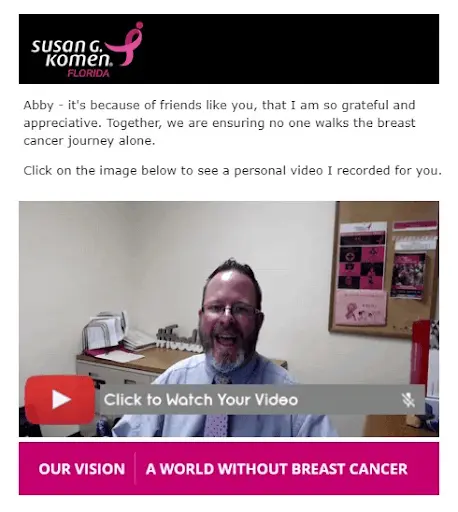
Social media donor spotlights demonstrate the value of your nonprofit organization’s mission
Donor shoutouts on social media require careful planning, but they can pay off by helping you reach new audiences. Spotlights like the example below from Kramden Institute can live on either your social media timeline or website and serve as a way to highlight the contributions of donors. Of course, you’ll need donor consent to produce this content and the ability to create professional photos to showcase on your social channels. But the payoff of putting a face to your community of support is that it can encourage others to become part of the work you do.

Take these examples to heart and produce a thank you letter to donors that compliments your fundraising approach and cultivates a mindset of gratitude. You’ll discover that your nonprofit organization will reap the benefits with increased donor retention and a culture of positivity that gives back to both your organization and the community.
Learn more about the best donor thank you letters and how to amplify your mission with our free nonprofit messaging guide.